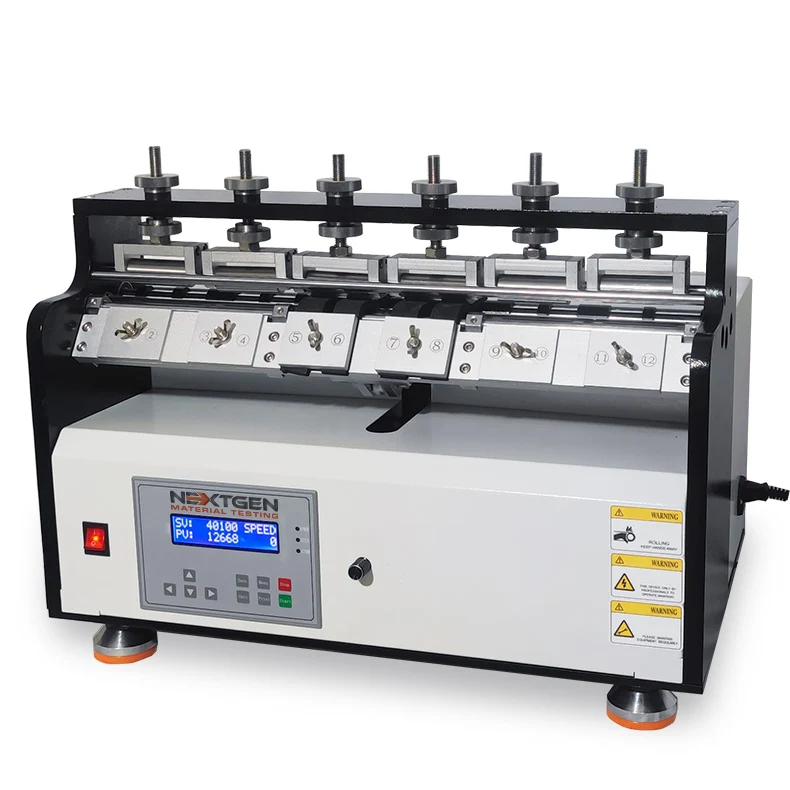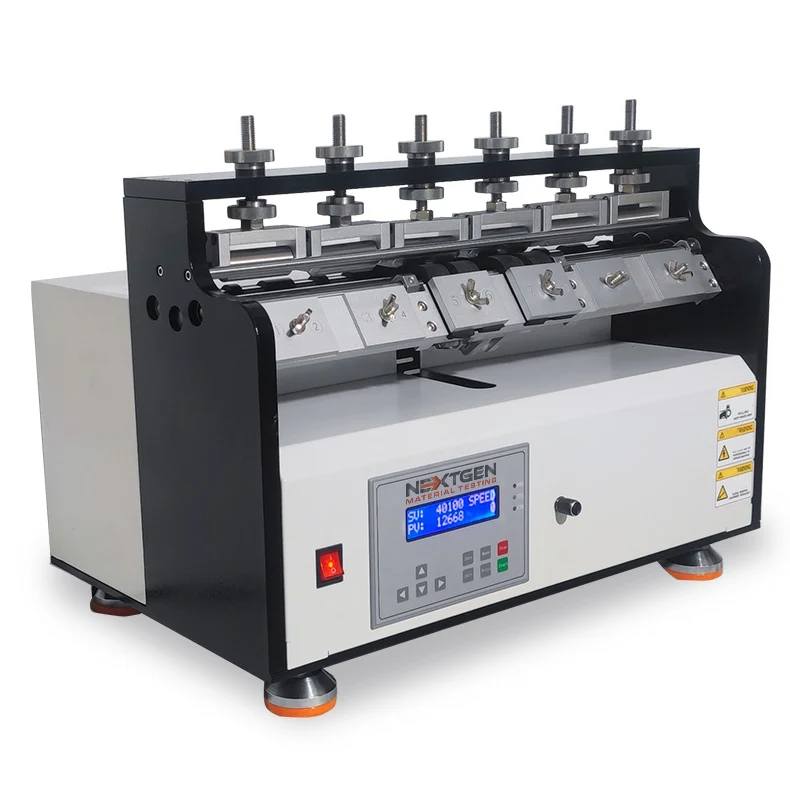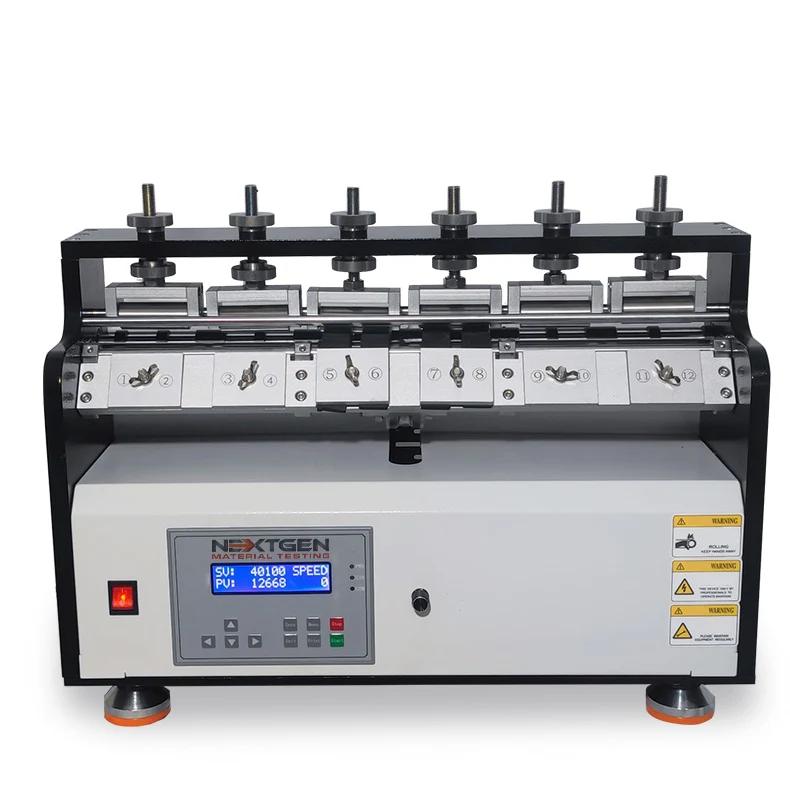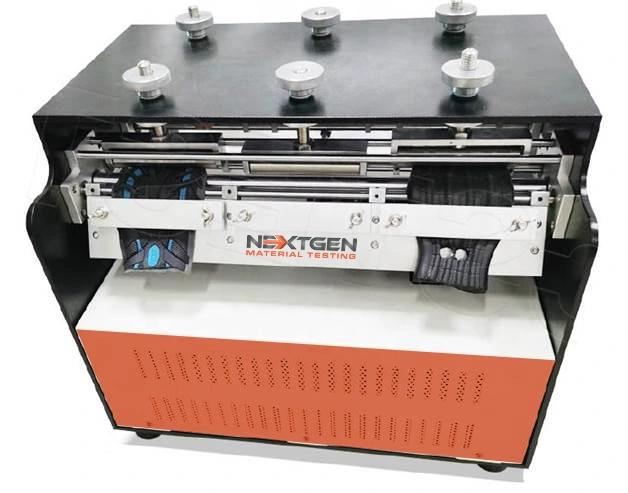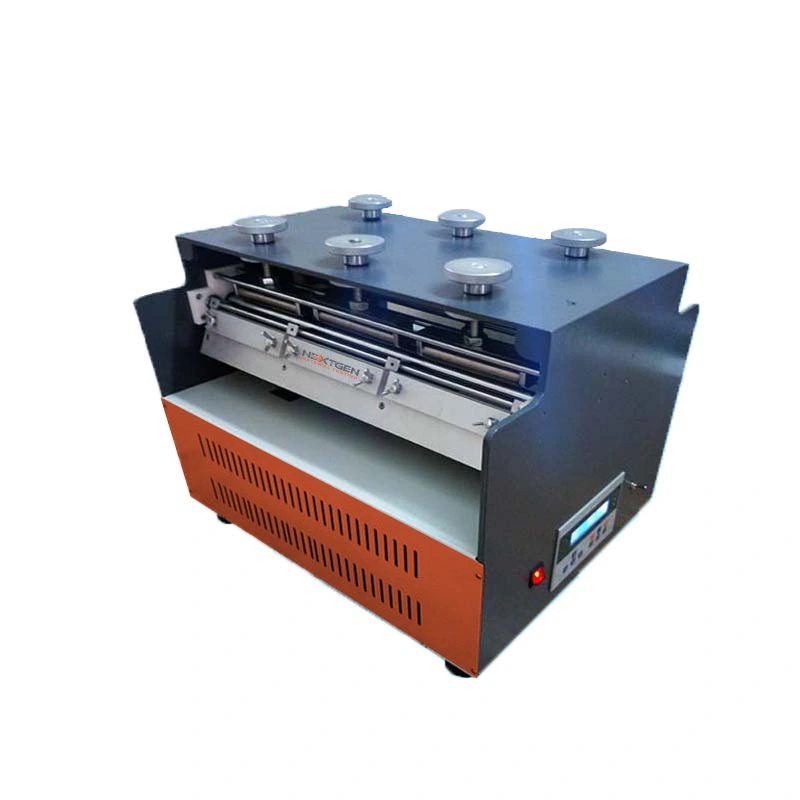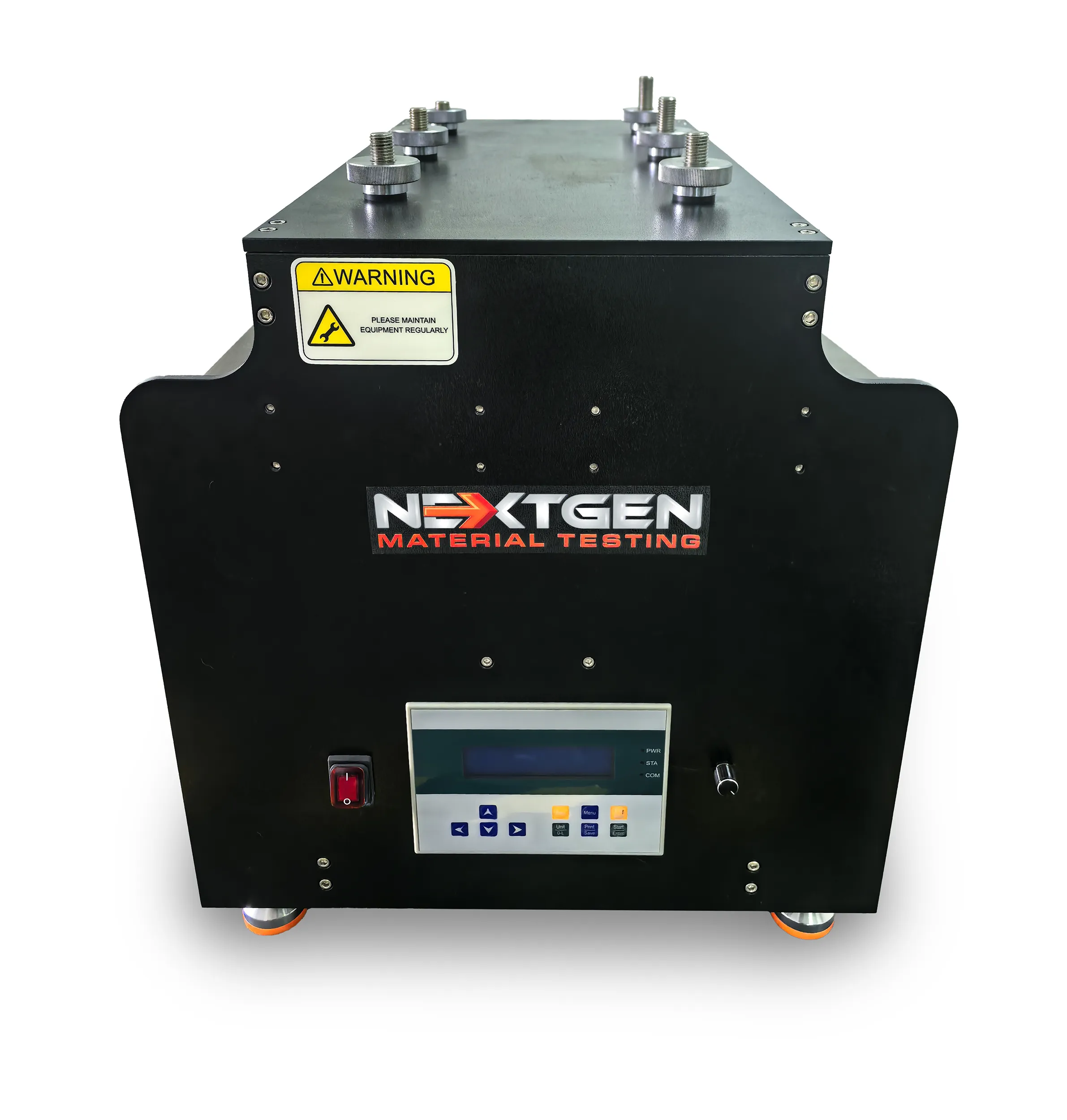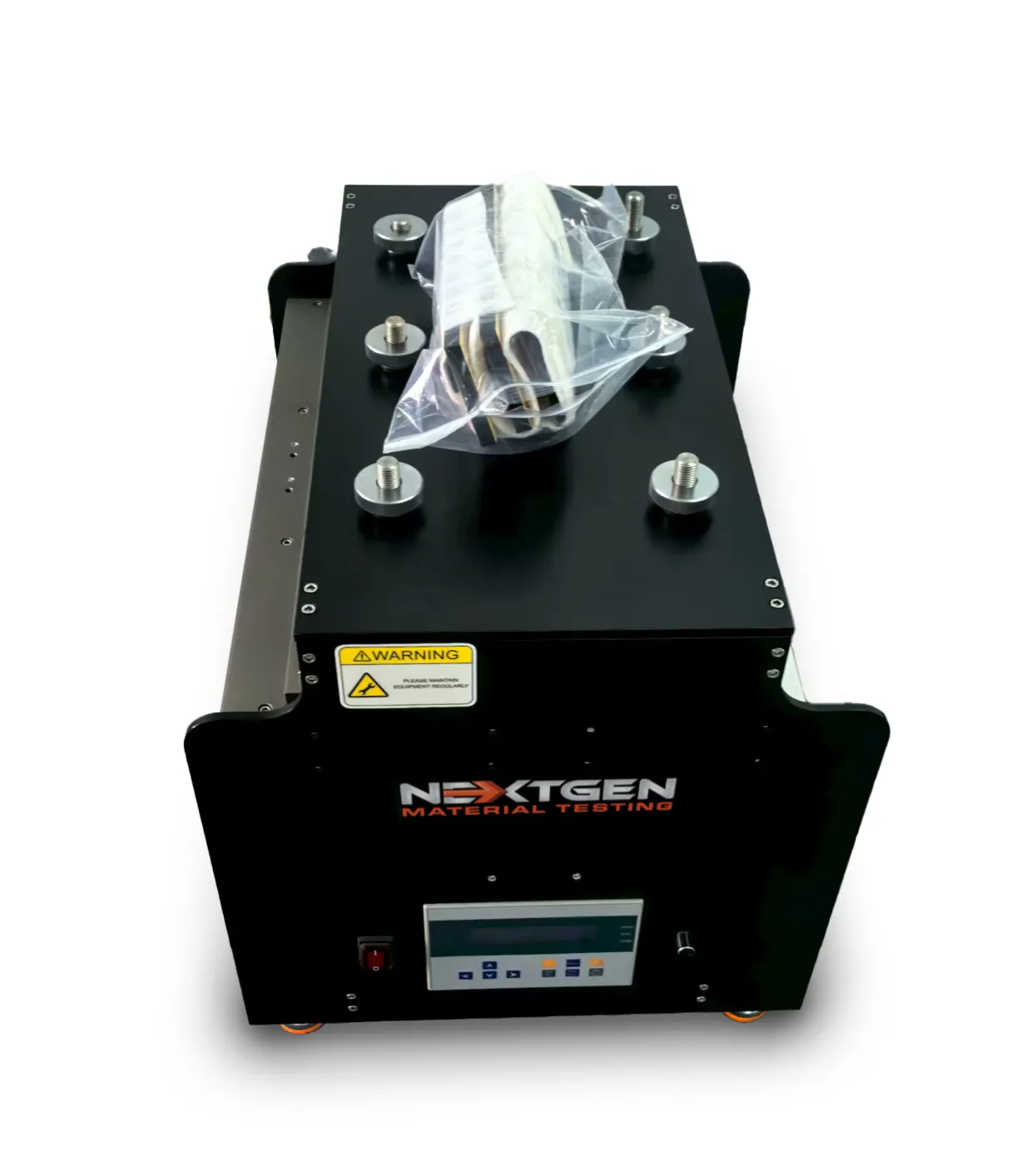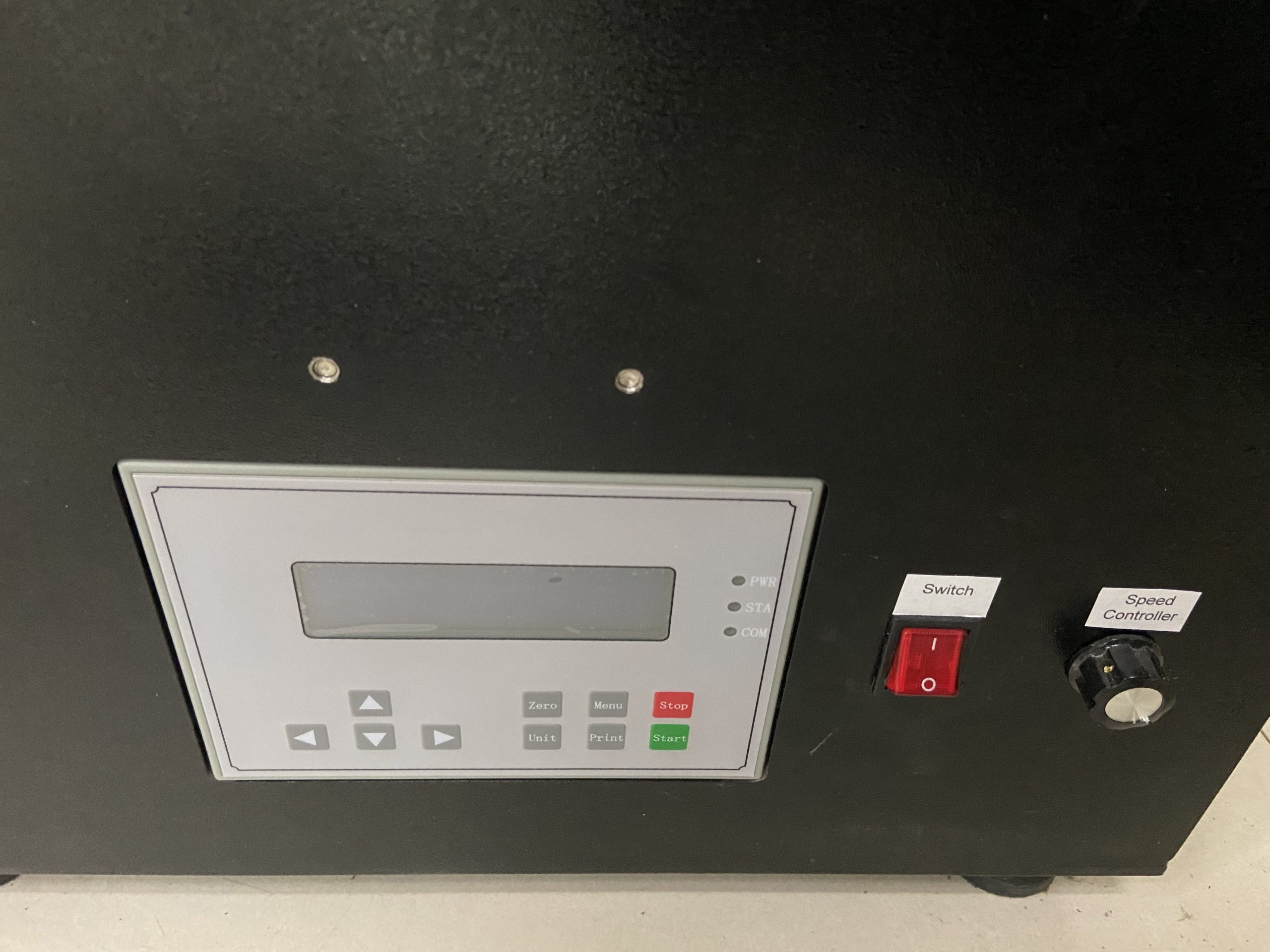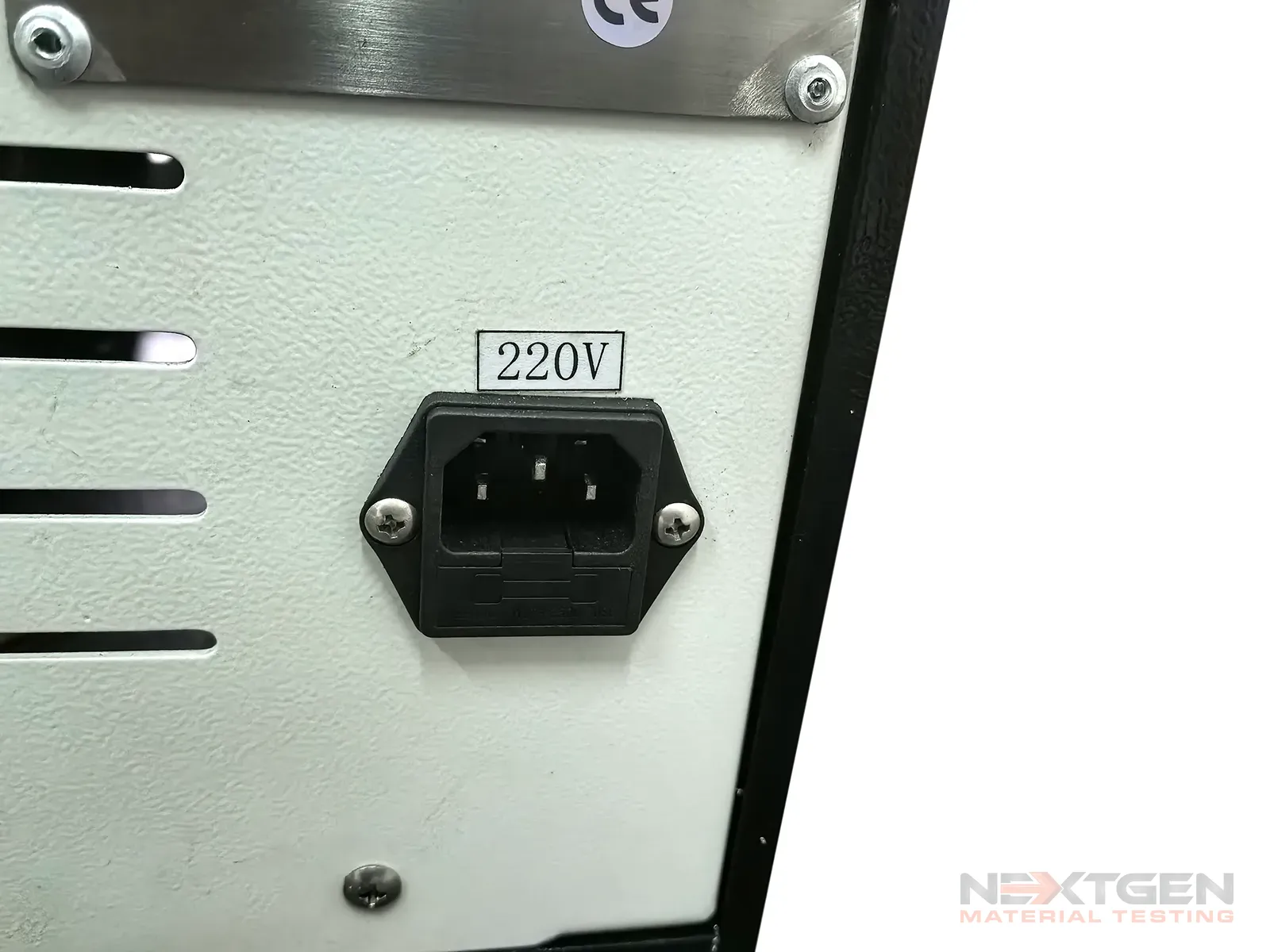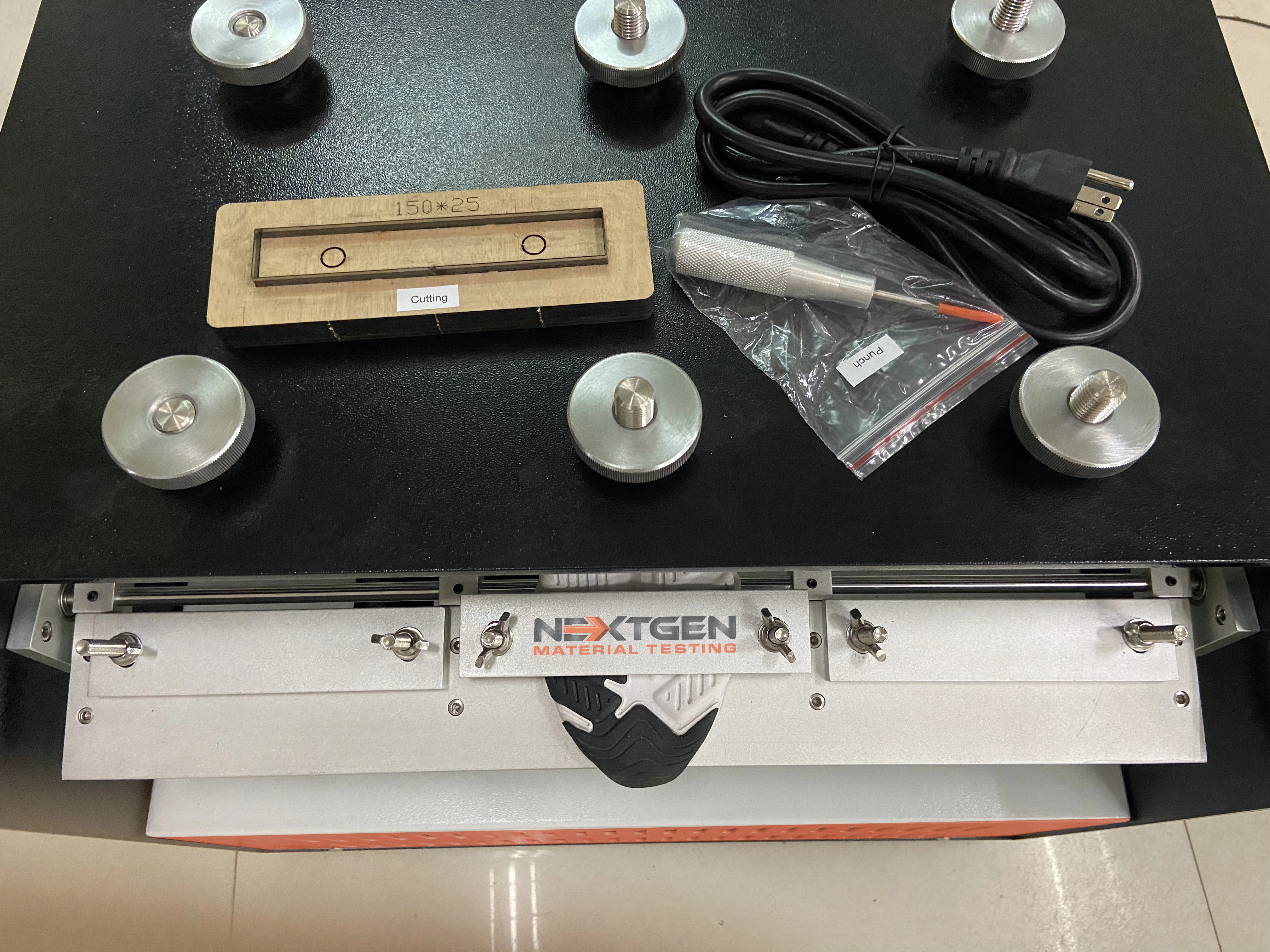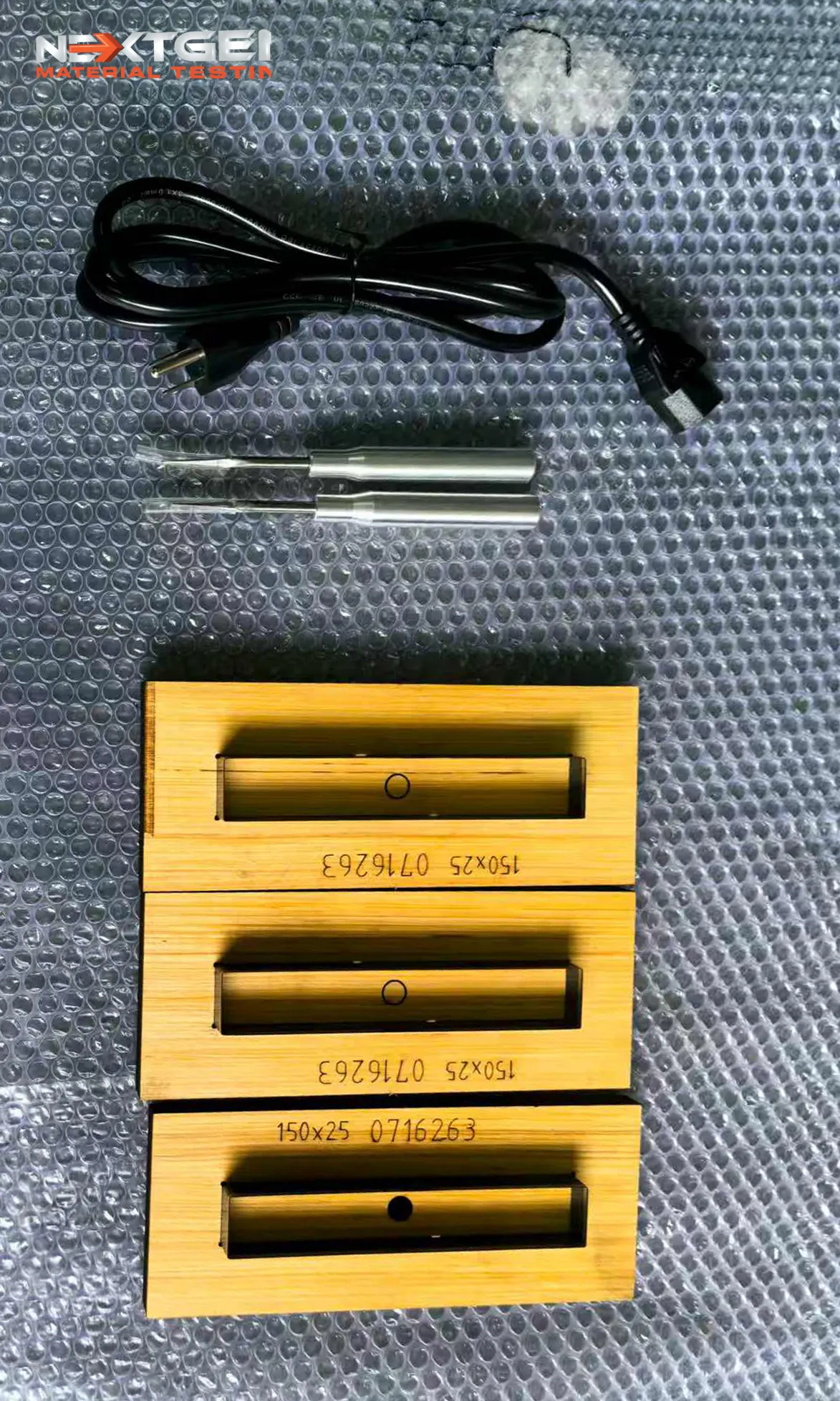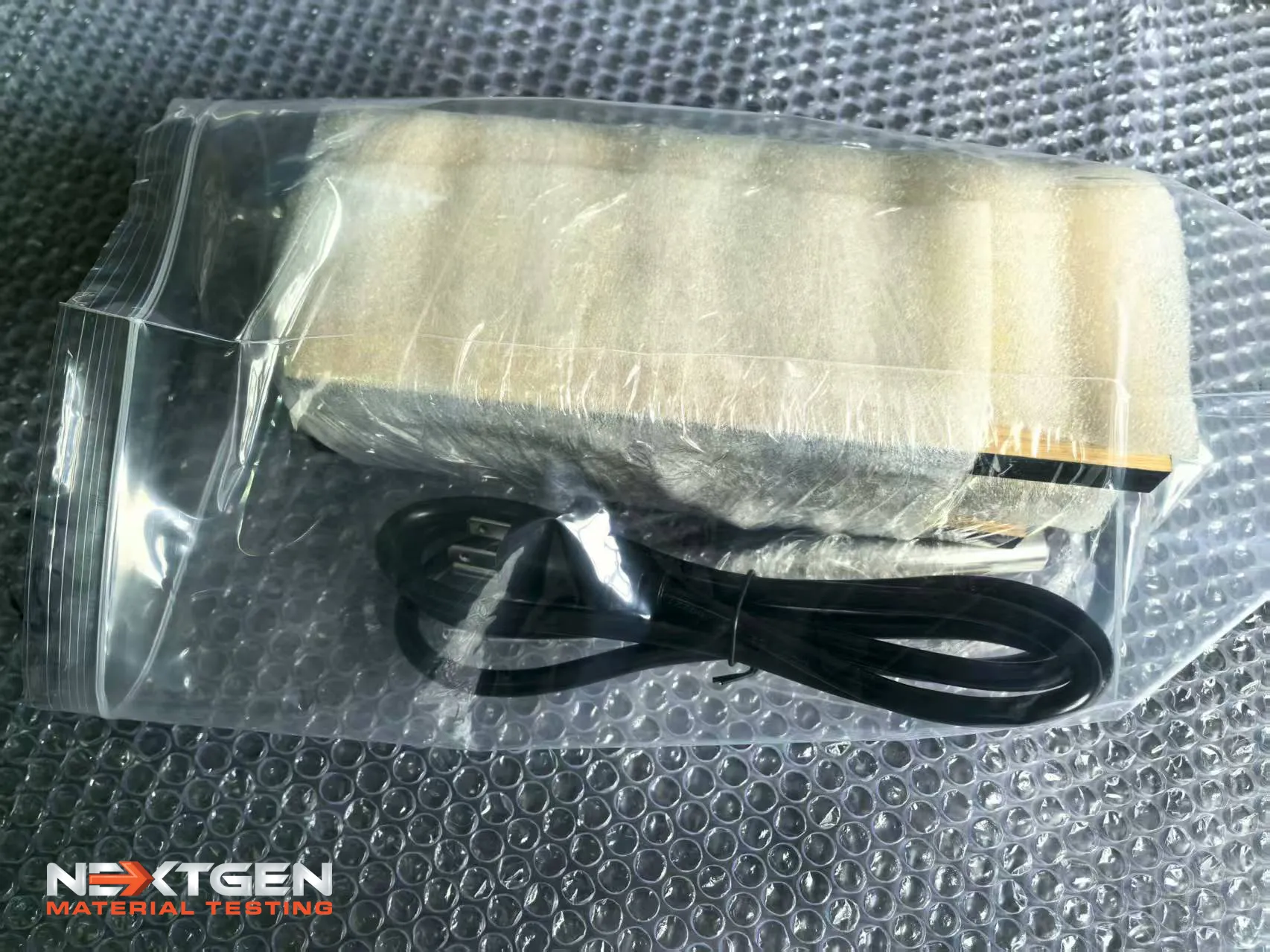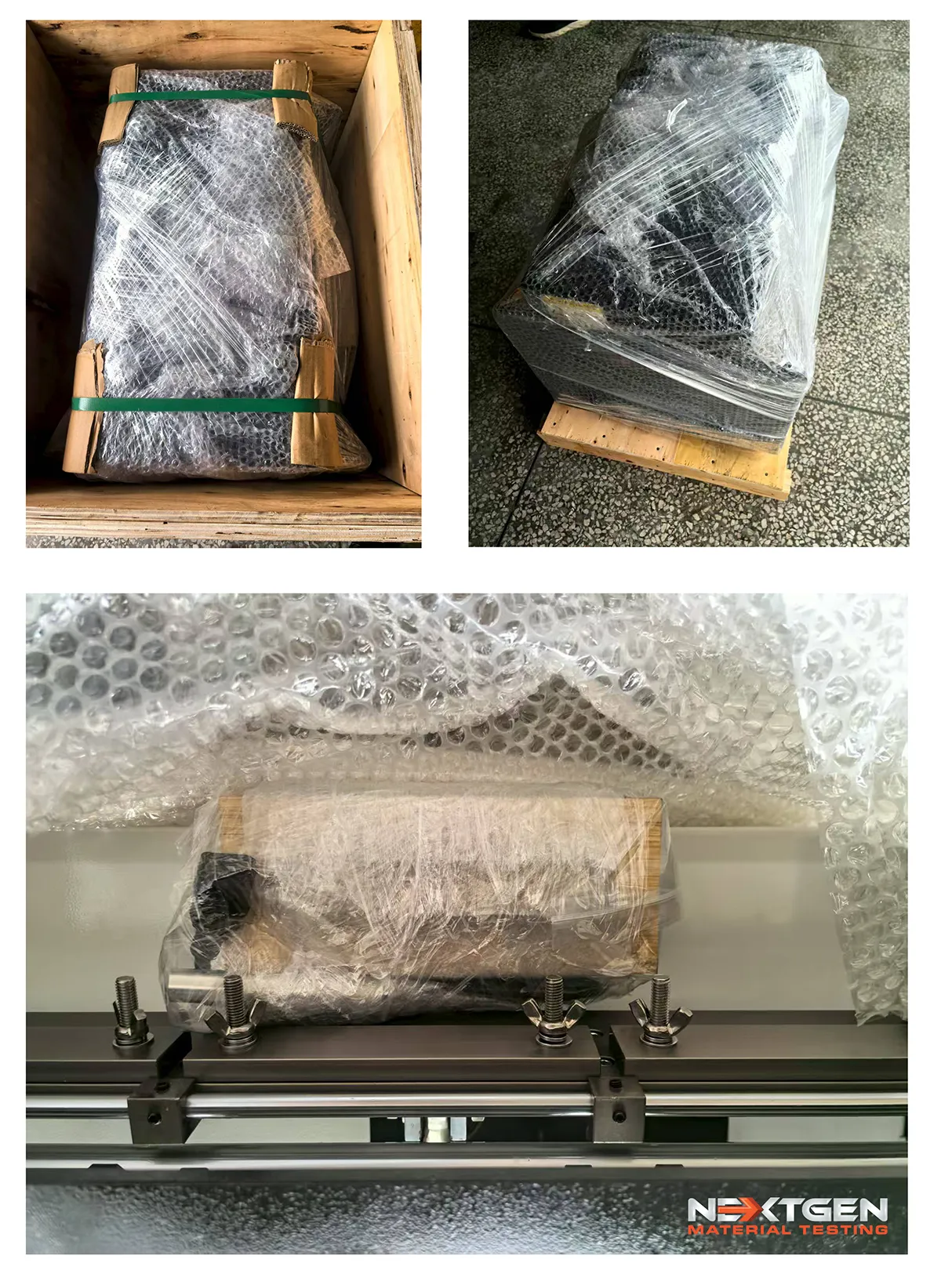Rubber Testing Equipment
Standards
ASTM D1052, ISO 5423, SATRA TM60






Description
Ross Flex Tester is designed to determine the resistance of vulcanized or synthetic elastomers to cut growth. The system does so under continuously bend flexing in 90°. This digital system has a memory function and is suitable for PU, PVC and TPR foams. It is particularly used for shoe soles because it is capable of testing virtually any flexible sheet-like material. After continuous bending, the damage and cracking degree is examined. The machine clamps the end of the test specimen to the holder arm while the pierced end is placed between two rollers that must permit a free bending movement of the test specimen during the test. During each of the test cycles, the pierced area of the test specimen is bent freely over a 10-mm(0.4 in.) diameter rod through a 90° angle. According to the industry standard, the Ross Flex tester operates at 1.7 ± 0.08 Hz (100 ± 5cpm). After a specified number of tests, the operator will measure the length of the notch of the test piece, and evaluate the zigzag resistance of the test sole relative to the notch growth rate.
Technical Specifications
| Model | NG-ROSS-6 | NG-ROSS-12 |
|---|---|---|
| # Grips | Grips for 6 test films | Grips for 12 test filmsOr 6 outsoles |
| Bending Angle | 90 +/- 20 | |
| Bending Speed | 100±3 CPM | |
| Dimensions (WxDxH) | 19.7x24x21.6" (500 x 610 x 550 mm) |
|
| Net Weight | 231 lbs / 105 kgs | |
| Power Supply | 110V/60Hz/1Ph | |
| Vacuum Pressure | 65mmm-Hg | |
Standard Configurations
- Main unit
- 1pc standard die mould
- 1pc hole puncher
- System Manual
FAQs
ASTM D1052 is an industry-standard test method that measures the ability of the material to withstand the formation and growth of a cut or crack when subjected to repeated bending stresses.
The test involves clamping one end of the test specimen to a holder's arm while the pierced end is placed between two rollers that permit a free bending movement of the test specimen during the test. The pierced area of the test specimen is bent freely over a 10-mm (0.4 in.) diameter rod through a 90° angle at a specified frequency. After a specified number of test cycles, the length of the notch of the test piece is measured, and the zigzag resistance of the test sole relative to the notch growth rate is evaluated.
The NextGen Ross Flex Tester is designed to test virtually any flexible sheet-like material, including PU, PVC, and TPR foams. It also complies with ASTM D1052 standard.
Click here to request a personalized quote from our team.
ISO 5423 is a standard that specifies determining the resistance of rubber and plastics to flex cracking. You can apply it to both vulcanized and thermoplastic materials. Moreover, it is applicable to any material that can be formed into a sheet-like shape.
ISO 5423 test method involves subjecting a test specimen to continuous flexing at a specified frequency and bending angle until a crack or cut is observed. The test specimen is in the form of a V-shape, and the apex of the V is subjected to the flexing motion. The test is performed at room temperature and under controlled conditions to ensure reproducible results.
ISO 5423 specifies the number of test cycles, the bending angle, and the bending frequency required for the test and provides a rating system for evaluating the degree of cracking or cut growth.
NextGen’s Ross Flex Tester complies with ISO 5423 standard.
Click here to request a personalized quote from our team.
SATRA TM60 determines the resistance of shoe soles and other flexible materials to flex cracking.
The test method involves subjecting a test specimen to repeated flexing at a constant speed and under controlled conditions until a crack or cut is observed. The test specimen can be of various shapes, such as a rectangle or trapezium, clamped at one end while the other is moved back and forth in a reciprocating motion.
The SATRA TM60 test method specifies the number of flex cycles, the frequency of flexing, and the criteria for evaluating the degree of cracking or cut growth. The standard also provides guidelines for specimen preparation, test equipment, and data analysis. SATRA TM60 is widely used in the footwear and leather industry to evaluate the durability and performance of shoe soles and other flexible materials.
NextGen’s Ross Flex Tester complies with SATRA TM60 standard.
Click here to request a personalized quote from our team.
The maximum bending angle of NextGen's Ross Flex Tester is 90 degrees, with a tolerance of +/- 20 degrees. During each test cycle, the pierced area of the test specimen is bent freely over a 10-mm diameter rod through a 90-degree angle, in accordance with the industry standard.
This parameter evaluates the resistance of vulcanized or synthetic elastomers to cut growth. By subjecting the material to continuous flexing at a fixed angle, the machine can determine the material's ability to resist cracking or damage over time.
NextGen's Ross Flex Tester is designed to operate at a frequency of 1.7 ± 0.08 Hz (100 ± 5 cpm) in order to provide consistent and repeatable results. The machine is also capable of testing up to 12 specimens simultaneously, which enables efficient testing of large batches of materials.
Click here to request a personalized quote from our team.
NextGen Material Testing Ross Flex Tester is a versatile machine designed to test the resistance of vulcanized or synthetic elastomers to cut growth. The machine can be used to test a wide variety of flexible sheet-like materials, including PU, PVC, and TPR foams, as well as other materials commonly used in the footwear industry.
The Tester is particularly useful for testing shoe soles subject to continuous bending and flexing during use. By subjecting the soles to continuous flexing in 90-degree angles, NextGen's Ross Flex Tester can determine its ability to resist cracking or damage over time.
In addition to shoe soles, the Ross Flex Tester can test rubber, leather, textiles, and plastics. The machine can test up to 12 specimens simultaneously, which enables efficient testing of large batches of materials.
To sum up, NextGen's Ross Flex Tester is a valuable tool for quality control and product development in the footwear and flexible material industry.
Click here to request a personalized quote from our team.
NextGen Ross Flex Tester is a cutting-edge material testing machine that is designed to determine the resistance of vulcanized or synthetic elastomers to cut growth. You can perform tests on polyurethane (PU), polyvinyl chloride (PVC), and thermoplastic rubber (TPR) foams.
NextGen Material Testing Ross Flex Tester is particularly useful for testing the durability of elastomers used in shoe soles. It can simulate the bending and flexing experience of the soles during everyday use. The unit can test up to 12 specimens simultaneously, which enables efficient testing of large batches of materials.
In addition to shoe soles, Ross Flex Tester can test a wide range of elastomers commonly used to manufacture various products. The tester is equipped with a memory function and can be programmed to perform a specific number of test cycles, ensuring consistent and repeatable results.
NextGen’s Material Testing Ross Flex Tester’s ability to accurately simulate real-world conditions makes it a valuable tool for quality control and product development in the footwear and flexible material industry.
Click here to request a personalized quote from our team.
The bending speed of the NextGen Material Testing Ross Flex Tester is an essential feature that enables it to simulate the bending and flexing of elastomers under real-world conditions. The industry standard is 1.7 ± 0.08 Hz, equivalent to 100 ± 5 cycles per minute (CPM). The tester is designed to bend the pierced area of the test specimen freely over a 10-mm (0.4 in.) diameter rod through a 90° angle during each test cycle.
The bending speed is a parameter that influences the accuracy and repeatability of test results. NextGen Ross Flex Tester's precise and consistent bending speed ensures that the testing conditions are controlled and repeatable, allowing accurate and reliable results.
The tester's bending speed is also adjustable, allowing for customized testing conditions based on the specific material being tested. This flexibility enables the Ross Flex Tester to be used for testing a variety of elastomers, including polyurethane, polyvinyl chloride, and thermoplastic rubber foams.
Click here to request a personalized quote from our team.
The NextGen's Ross Flex Tester can test multiple specimens simultaneously. The flex tester has 12 chamber systems, allowing it to test up to 12 specimens simultaneously. This feature saves time and increases productivity in the testing process, making it ideal for use in high-volume production environments.
The ability to test multiple specimens simultaneously is useful when testing materials with a high degree of variability, such as elastomers. By testing multiple specimens simultaneously, the machine can provide a more accurate representation of the material's properties, resulting in more reliable test results.
The NextGen Material Testing Ross Flex Tester's 12-chamber system is designed to securely hold each specimen during testing to prevent slipping or displacement resulting in high accuracy in test results. This system is also easy to set up and operate, allowing quick and efficient testing.
Click here to request a personalized quote from our team.
During the Ross Flex Test, the rollers hold the pierced end of the test specimen, allowing it to move freely and bend over a 10-mm (0.4 in.) diameter rod through a 90° angle, as industry standards require.
The rollers ensure that the test specimen does not slip or move out of position during the test, leading to inaccurate test results and other potential issues. The tester clamps the other end of the test specimen to the holder arm, ensuring it remains securely in place throughout the testing process.
The use of the rollers in the Ross Flex Tester also helps to prevent the test specimen from developing cracks or other forms of damage due to friction between the specimen and the testing equipment, in its turn ensuring that the test results are accurate and reliable.
To sum up, the two rollers in NextGen Material Testing Ross Flex Tester ensure that the test specimen or specimens are held securely and bend freely during the test.
Click here to request a personalized quote from our team.
NextGen’s Ross Flex Tester vacuum pressure is essential for holding test specimens in place during testing. The Flex Tester uses a vacuum to hold the specimens in place, ensuring they remain in position throughout the test.
The vacuum pressure of the NextGen Material Testing Ross Flex Tester is 65mm-Hg. This pressure level is sufficient to securely hold the test specimens in place, preventing any slippage or movement during the testing process. The vacuum pressure is adjustable. This allows operators to optimize the pressure according to the specific requirements of their testing applications.
The vacuum pressure is an important factor in ensuring the accuracy and reliability of the testing results. Without this feature, there is a risk that the test specimens could move or slip during the test, leading to inaccurate results. By using a vacuum to hold the specimens in place, NextGen's Ross Flex Tester ensures that the testing conditions are consistent and reliable, producing accurate and repeatable results that can be used for quality control and product development purposes.
Click here to request a personalized quote from our team.
NextGen's Ross Flex Tester tests the resistance of materials to cut growth. One of the critical components of the test is the diameter of the rod used during the testing process. The tester is designed to bend the test specimens over a 10-mm (0.4 in.) diameter rod through a 90-degree angle during each of the test cycles.
The diameter of the rod used during the test should be consistent with the industry standards set out in ASTM D1052, ISO 5423, and SATRA TM60. NextGen Material Testing Ross Flex Tester complies with these standards, and the rod diameter used during testing is optimized to ensure consistent and reliable results.
The maximum diameter of the rod used during the Ross Flex Test is 10 mm (0.4 in.). This diameter ensures that the test specimens can be bent freely over the rod without excessive stress or strain, while still providing sufficient resistance to ensure accurate and reliable testing results.
Click here to request a personalized quote from our team.
NextGen Material Testing Ross Flex Tester is a digital system designed to determine the resistance of vulcanized or synthetic elastomers to comply with industry standards, including ASTM D1052, ISO 5423, and SATRA TM60.
According to industry standards, NextGen Ross Flex Tester operates at 1.7 ± 0.08 Hz (100 ± 5cpm). This frequency ensures that the test specimens are subjected to a consistent and repeatable bending motion during the testing process. By subjecting the specimens to the same bending frequency, the Ross Flex Tester can accurately measure the material's resistance to cut growth.
The frequency of operation for the Ross Flex Tester is an essential parameter that can significantly impact the testing results. Therefore, using a machine that complies with industry standards and operates at the correct frequency is critical. NextGen Material Testing Ross Flex Tester meets industry standards frequency requirements, ensuring that the results obtained are reliable and accurate.
Click here to request a personalized quote from our team.
The damage and cracking degree of the specimen after the Ross Flex Test is evaluated by measuring the length of the notch of the test piece. The notch is the area where the material is subjected to the most stress during the test and is prone to damage and cracking. After a specified number of test cycles, the operator will measure the length of the notch to determine the degree of damage.
The degree of damage is evaluated based on the test specimen's zigzag resistance relative to the notch growth rate. The zigzag resistance is the material's ability to withstand repeated bending without cracking or breaking. A higher zigzag resistance indicates a more durable material.
The notch growth rate is the rate at which the damage to the notch increases over time due to repeated bending. The rate is measured by taking multiple readings of the notch length during the test. The length of the notch is plotted against the number of test cycles to determine the growth rate.
Click here to request a personalized quote from our team.
NextGen Material Testing Ross Flex Tester is designed to test the resistance of flexible sheet-like materials, such as vulcanized or synthetic elastomers, to cut growth. It is used for shoe soles, but it can be used to test various flexible materials. However, keep in mind that the tester clamps the end of the test specimen to the holder's arm while the pierced end is placed between two rollers which must permit a free bending movement of the test specimen during the test. Therefore, the material being tested needs to have a sheet-like shape in order to be clamped and flexed by the machine.
For non-sheet-like materials, other testing machines may be more appropriate. For example, NextGen Universal Testing Machines are designed to test a wide range of materials, including metals, plastics, and textiles. It can perform tension, compression, bending, shearing, and peeling tests, making it a versatile testing machine for a variety of materials. Therefore, it is crucial to choose the appropriate testing machine based on the material being tested and the specific testing requirements.
Click here to request a personalized quote from our team.
Yes, NextGen Material Testing Ross Flex Tester can be customized for specific applications based on the customer's requirements. The standard configuration of the machine includes 12 chamber systems and is capable of testing 12 specimens simultaneously. Nevertheless, you can modify the number of chamber systems, grips, and other parameters to meet your specific needs.
For instance, NextGen can customize the unit to test larger or smaller specimens or modify the bending angle and speed to meet specific industry testing standards. We can also customize the tester to work with specific types of elastomers or other materials.
NextGen's engineers and technicians work closely with clients to understand their testing needs and provide personalized solutions that meet their specific requirements. We have a wealth of experience in designing and manufacturing material testing equipment, and you can rely on our expertise to deliver high-quality, customized products.
Click here to request a personalized quote from our team.
NextGen Material Testing Ross Flex Tester is designed for durability and reliable performance, but regular maintenance is necessary to ensure accurate testing results and prolong the machine's lifespan. The tester must be kept clean and free of debris, dust, and other contaminants. The rollers must be checked for any damage or signs of wear and tear and cleaned and lubricated as necessary. The grips and holders must also be inspected and cleaned to ensure they are in good working order.
Additionally, the tester must be calibrated regularly to ensure accurate results. Calibration involves testing the machine with known specimens to ensure it operates within the required standards. Calibration should be performed by a trained technician using specialized equipment.
You also need to follow the manufacturer's guidelines for maintenance and use only recommended parts and accessories. A qualified technician must perform any repairs or replacement of parts. By following these guidelines, NextGen Material Testing Ross Flex Tester will provide accurate and reliable testing for many years.
Click here to request a personalized quote from our team.
NextGen Material Testing Ross Flex Tester is a highly accurate digital testing system designed to determine the resistance of vulcanized or synthetic elastomers to cut growth. The operational accuracy is 1.7 ± 0.08 Hz (100 ± 5cpm) which meets the industry standards. Such accuracy parameters ensure that the test results are reliable and can be used to make informed decisions about the quality and durability of the tested materials.
The tester has a memory function that ensures the testing conditions are consistent throughout the testing process. This helps to reduce errors caused by changes in temperature, humidity or other external factors. The Flex Tester is equipped with advanced software that allows operators to monitor and analyze the test results in real time, making it easy to identify any deviations or anomalies that may affect the accuracy of the results.
Regular maintenance is required to ensure that the NextGen's Ross Flex Tester remains accurate and reliable. This includes cleaning and calibration of the tester and routine inspections to identify any signs of wear or damage that may affect its performance.
Click here to request a personalized quote from our team.
NextGen Material Testing Ross Flex Tester must be calibrated regularly to ensure test results' accuracy and the unit's reliability.
NextGen's Ross Flex Tester is calibrated using calibration weights by placing them on the machine's platform. Weights are selected based on the desired load to verify the tester's accuracy. Only a qualified technician must perform the calibration process.
The calibration procedure involves verifying the accuracy of the machine's force and displacement measurements. The force is verified using a load cell calibration procedure, while the displacement is verified using a linear displacement transducer calibration procedure. During the calibration procedure, the operator also verifies the machine's alignment and checks for any wear or damage to the tester's components.
Regular calibration of the NextGen Ross Flex Tester is recommended to ensure the continued accuracy and reliability of the test results.
Click here to request a personalized quote from our team.
Ross Flex Tester is designed to determine the resistance of vulcanized or synthetic elastomers to cut growth. The system does so under continuously bend flexing in 90°.
Technical Specifications:
|
Model |
NG-ROSS |
|
# Grips |
12 Chamber Systems |
|
Bending Angle |
90 +/- 20 |
|
Bending Speed |
100±3 CPM |
|
Dimensions (WxDxH) |
19.7x24x21.6" |
|
Net Weight |
231 lbs / 105 kgs |
|
Power Supply |
110V/60Hz/1Ph |
|
Vacuum Pressure |
65mmm-Hg |
Click here to request a personalized quote from our team.
Related Products
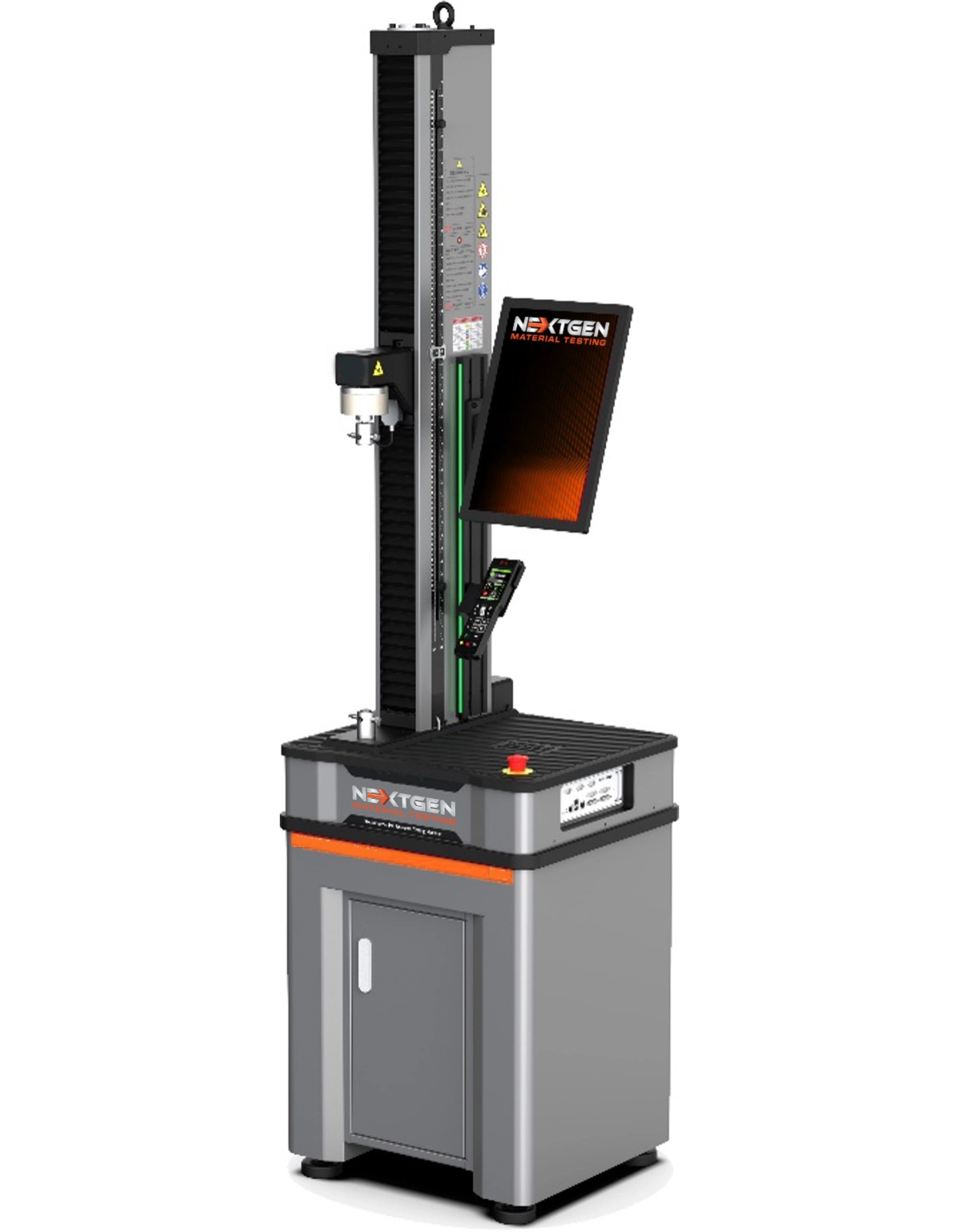
NG-EML Series A – Single Column Bench Top Universal Testing Machine (50 N – 5 kN)
The NG-EML Series A – Single Column Bench Top UTM (50 N–5 kN) is a precision electromechanical system designed for tension, compression, and flexural testing of low-force specimens. Featuring GenTest™ software, a high-speed servo drive, Class 0.5 accuracy, and USB/Ethernet control, this compact tabletop unit supports ASTM, ISO, and EN standards. Ideal for testing plastics, rubber, foams, films, composites, and thin metals.
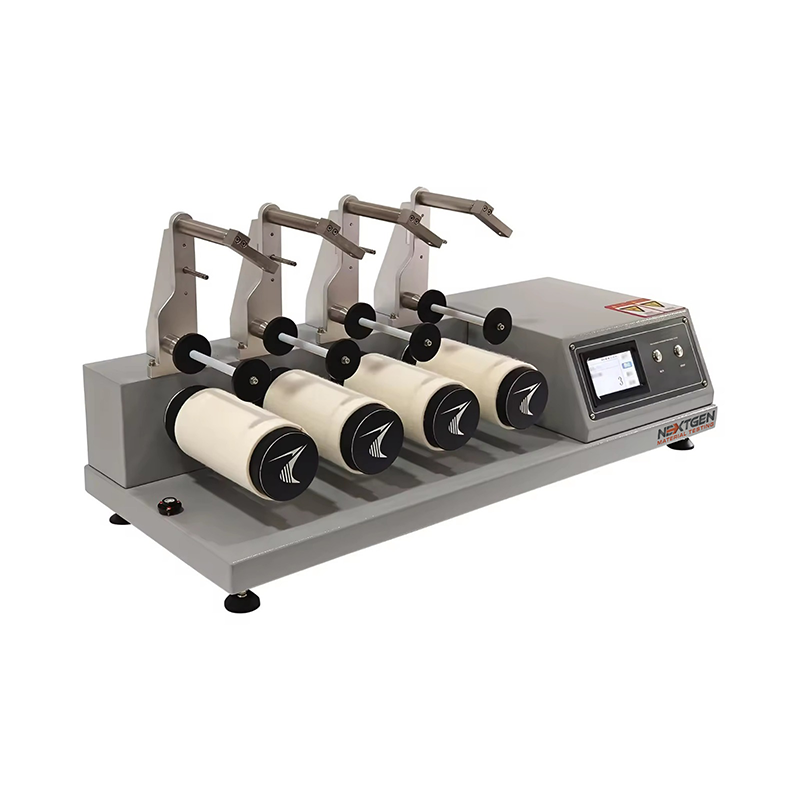
ICI / Mace Snag Tester
Discover the Fabric Textile ICI / Mace Snag Tester, a reliable tool for assessing fabric snagging under normal wear conditions.
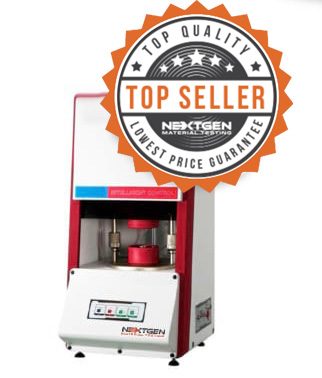
Moving Die Rheometer (MDR)
Introducing the NG-MDR Moving Die Rheometer, your solution for accurately assessing the curing and processing characteristics of vulcanized rubber compounds. Designed for precision, this state-of-the-art rheometer captures the characteristic curve and parameters of rubber vulcanization by measuring the torque applied to the oscillating die.
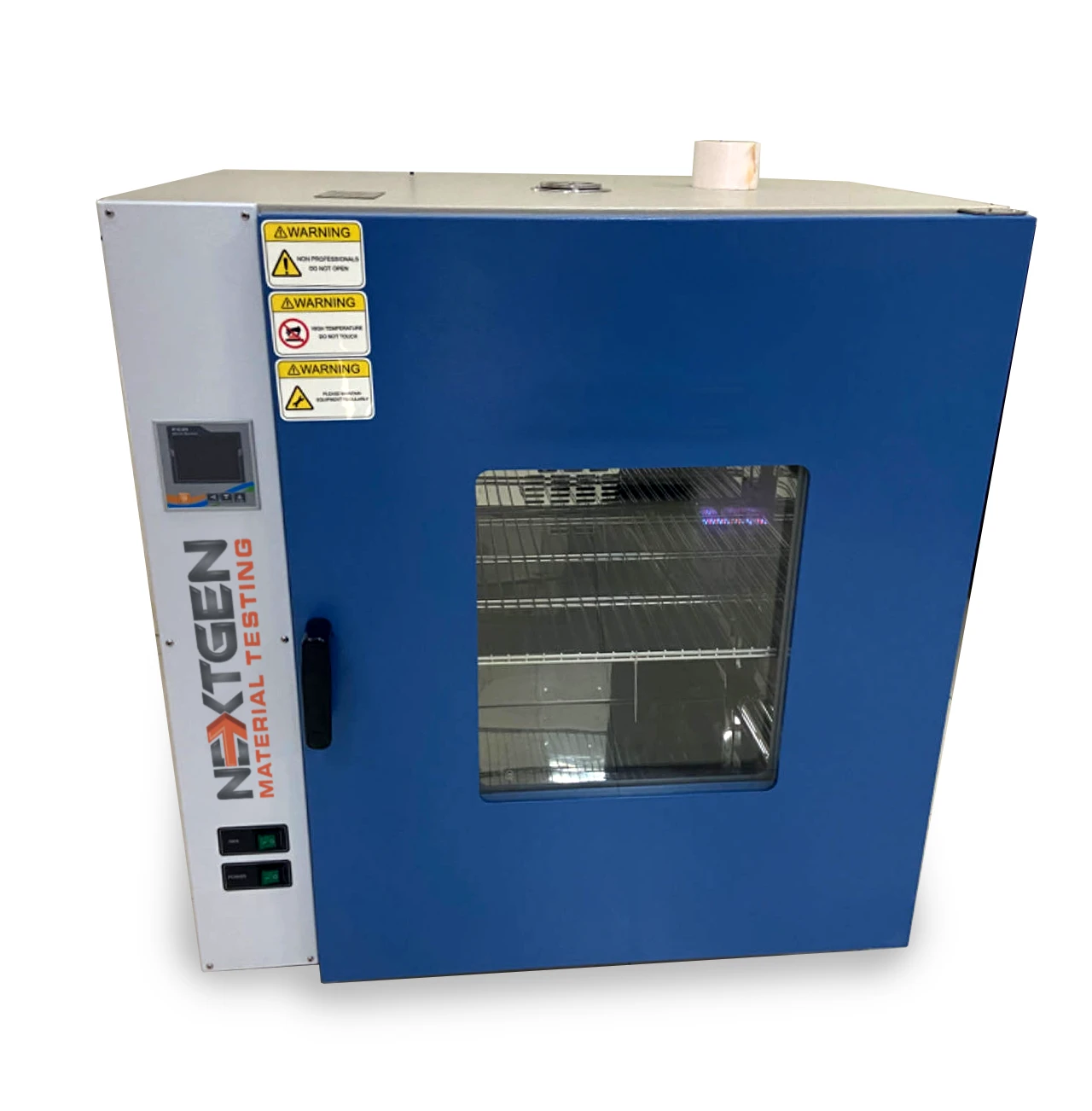
Aging Oven – High-Temperature Chamber – NG-AGOV-ADV
The NG-AGOV-ADV Aging Oven is designed for high-temperature testing of rubber, plastics, and insulating materials. It features programmable PID control, uniform airflow, and forced convection for stable and repeatable aging cycles. This system supports global testing standards including ISO 188, ASTM D573, and IEC 60216-4-1. With its durable stainless-steel chamber and user-friendly interface, it’s ideal for R&D, quality control, and certification labs.
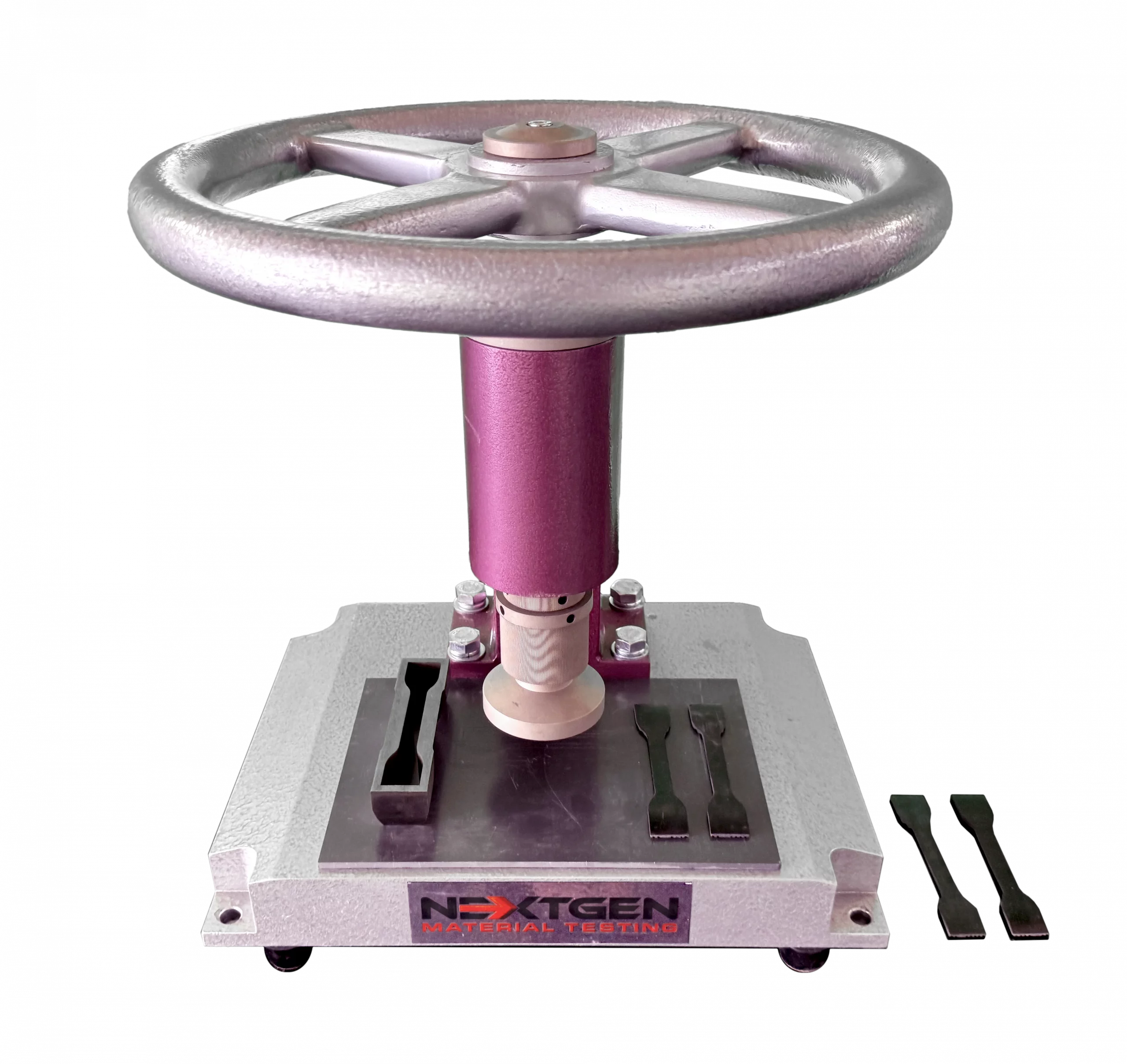
NG-T-Press M Series - Manual Cutting Press System for Rubber Tensile Specimens
Our newest manual cutting press system is suitable for laboratories to create specimens from rubber, tape, and special materials.
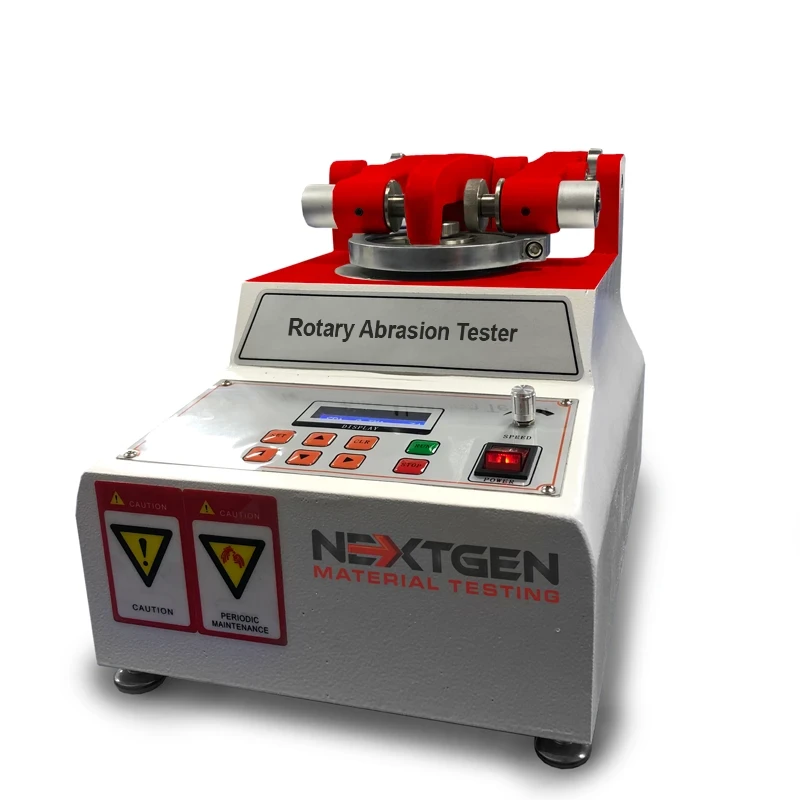
Rotary Abrasion Tester Single & Dual Wheel
GenRotary used evaluate abrasion resistance. It can conduct tests on a wide range of materials such as: cloth, paper, paint, plywood, leather, tile, glass, rubber etc. It tests the specimen by rotating it while in contact with the grinding wheel and applying the required pressure. The Joss of weight reflects on the change in weight of the specimen. The unit also has an intelligent power failure recovery function.
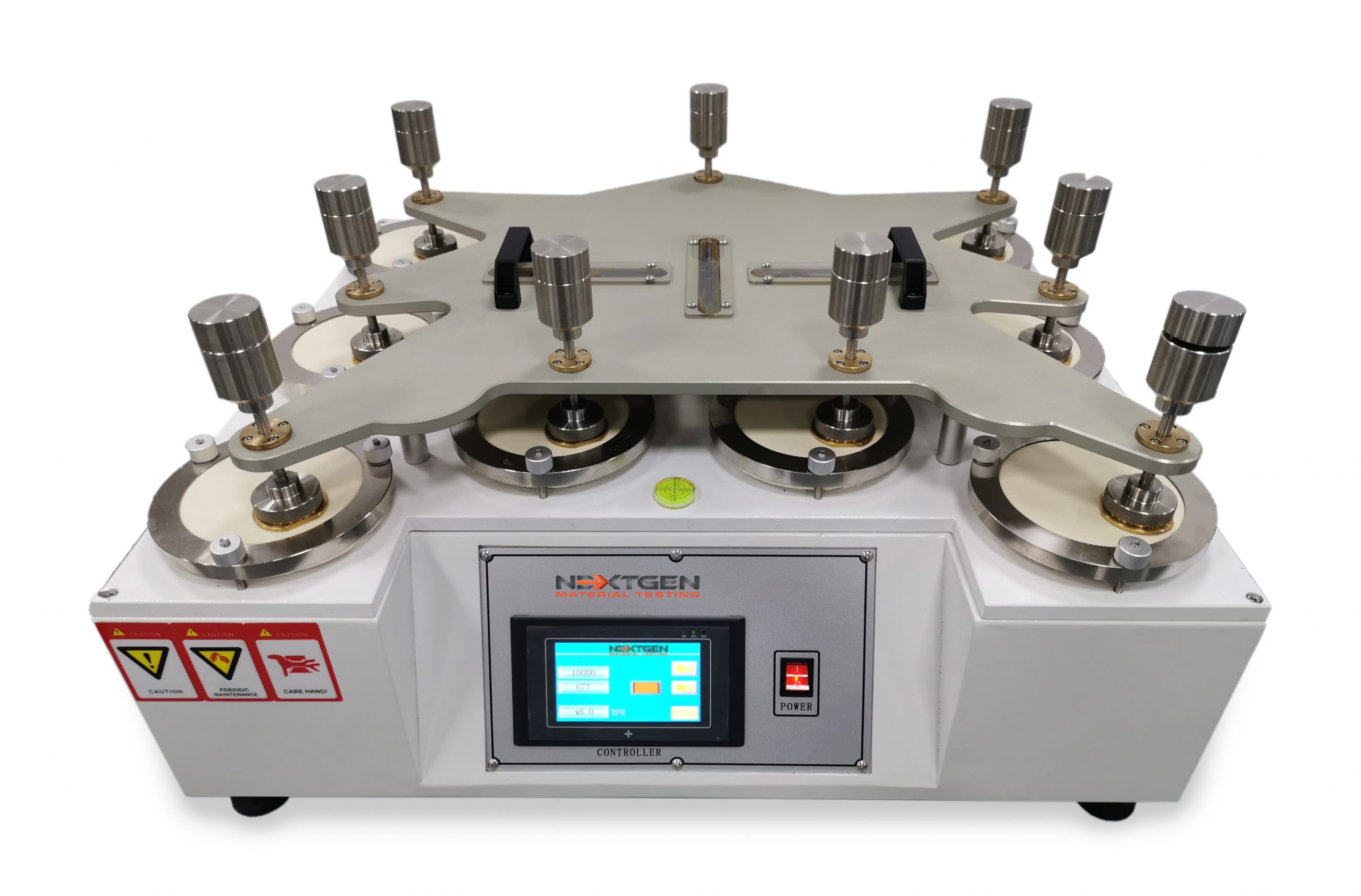
9-Station Martindale Abrasion Tester
The GenDale - Martindale Abrasion Tester is mainly used to test shoe fabric, shoe lining, and many other types of shoe related materials.
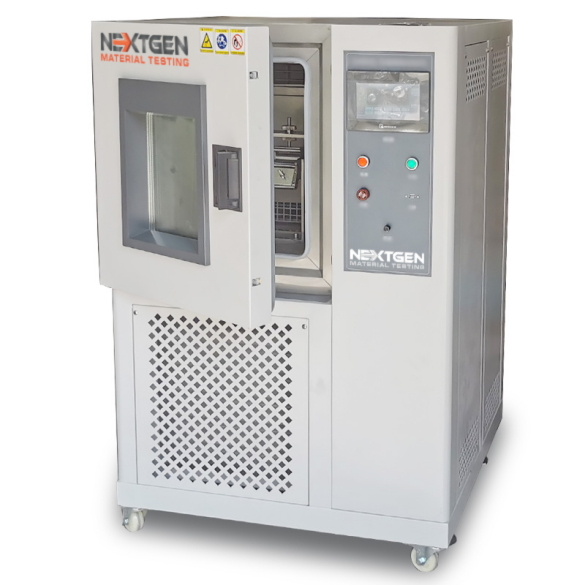
GenRoss-CH - Ross Flex Tester with Low Temperature Chamber
GenRoss-CH is an advanced Ross Flex Tester designed for assessing the cold resistance of materials in low temperature environments.

Linear Abrasion Tester
NextGen's linear abrasion meters evaluate the abrasion and scratch resistance of products, along with color transmission.
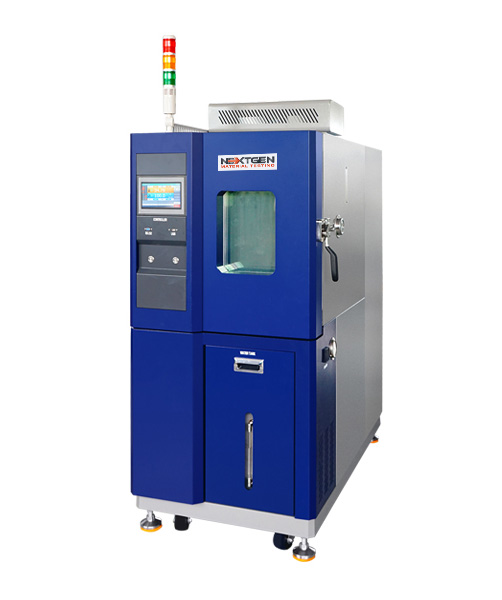
NextGen Environmental Chambers NG-EC 100,150,225,408,1000
The temperature and humidity NextGen Environmental Chambers features a sturdy cabinet made of cold-rolled steel and stainless steel.
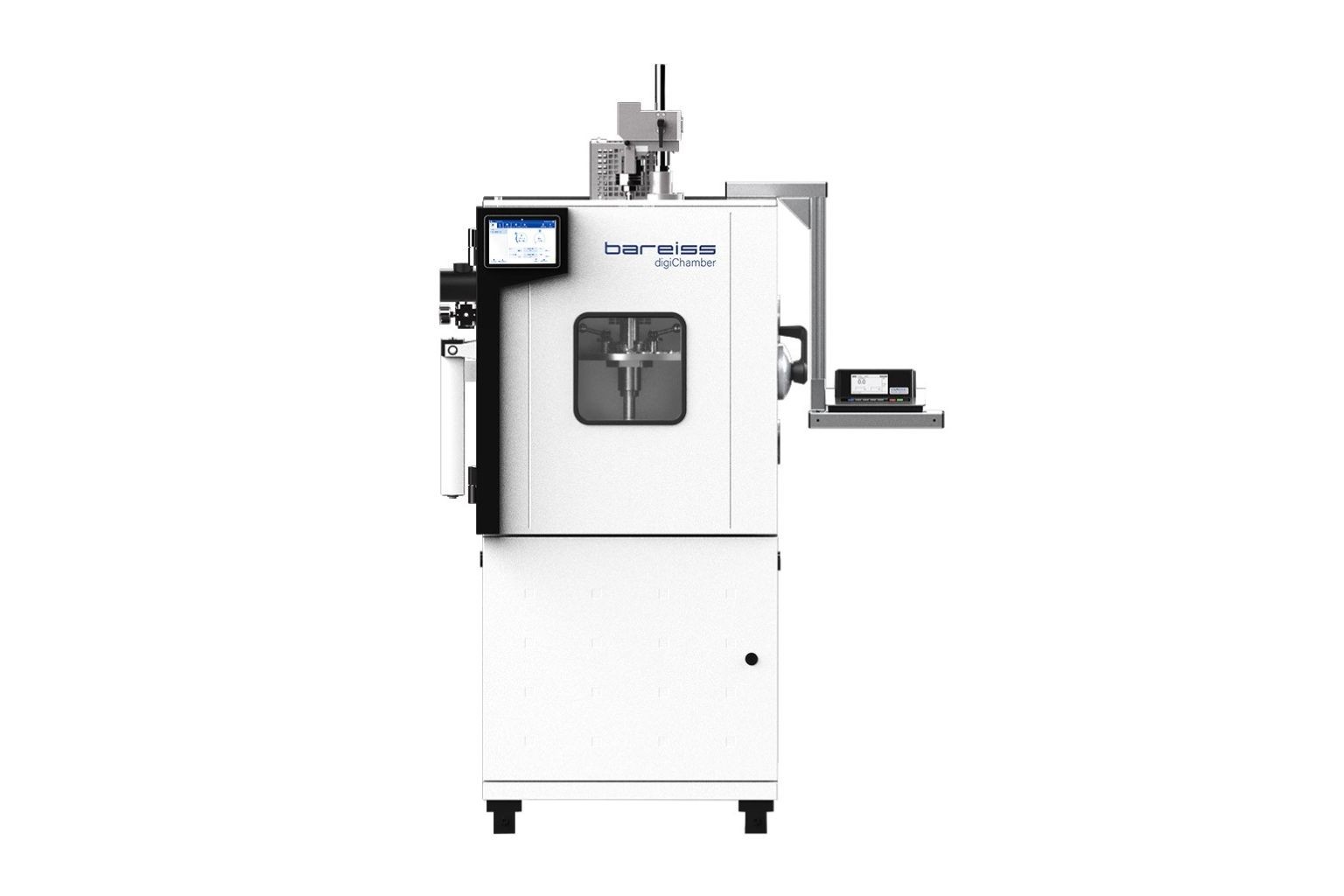
digiChamber - Temperature Controlled Hardness Testing
Discover digiChamber from NextGen Material Testing, the advanced temperature-controlled hardness tester developed by Bareiss.
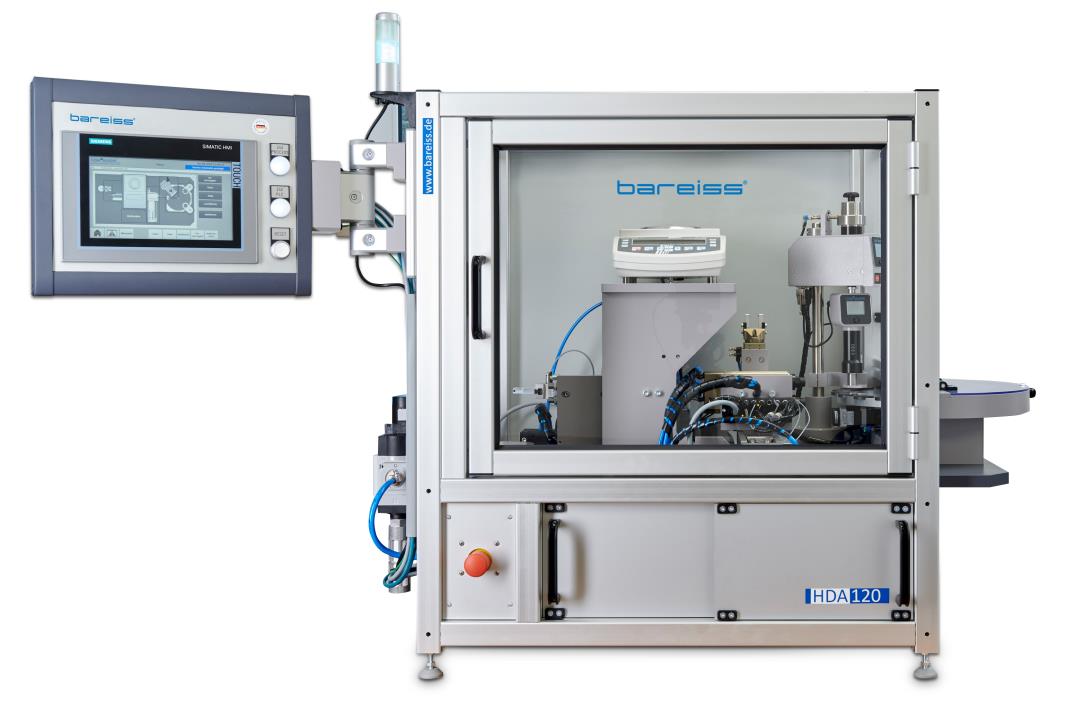
HDA 120 - Hardness and Density Automation Test System
The HDA 120 test system is a versatile solution for semi-automatic detection of sample hardness and density.
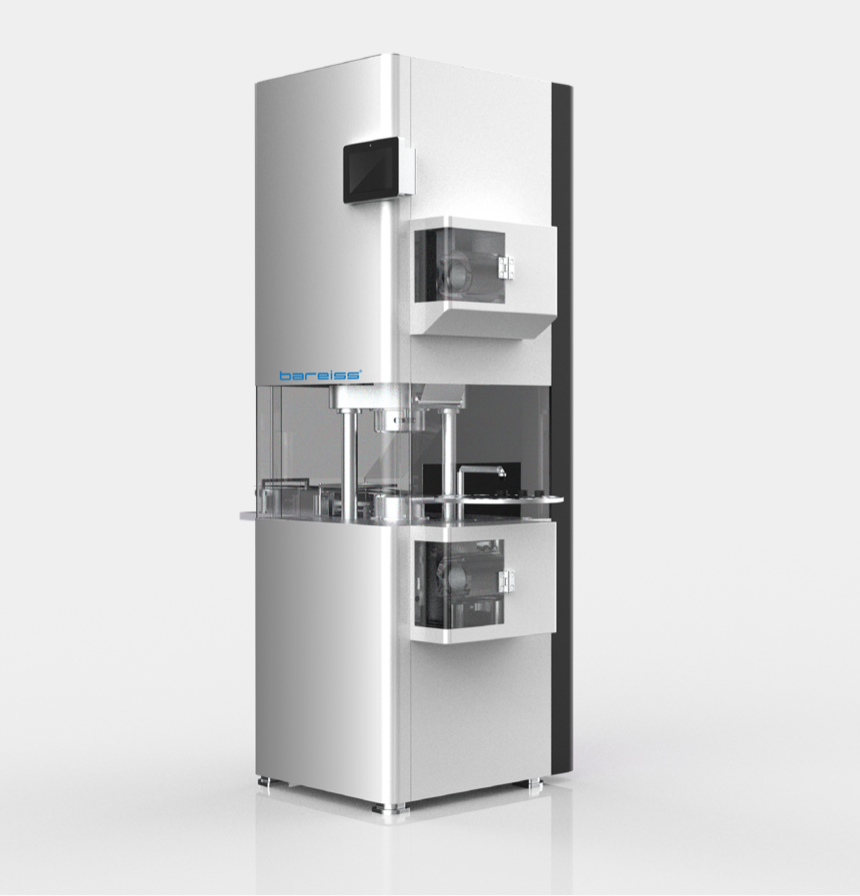
RPA Ultra - Advanced Rubber Process Analyzer Rheometer
RPA Ultra is an advanced rubber process analyzer rheometer that measures the dynamic and static characteristics of raw rubber compounds
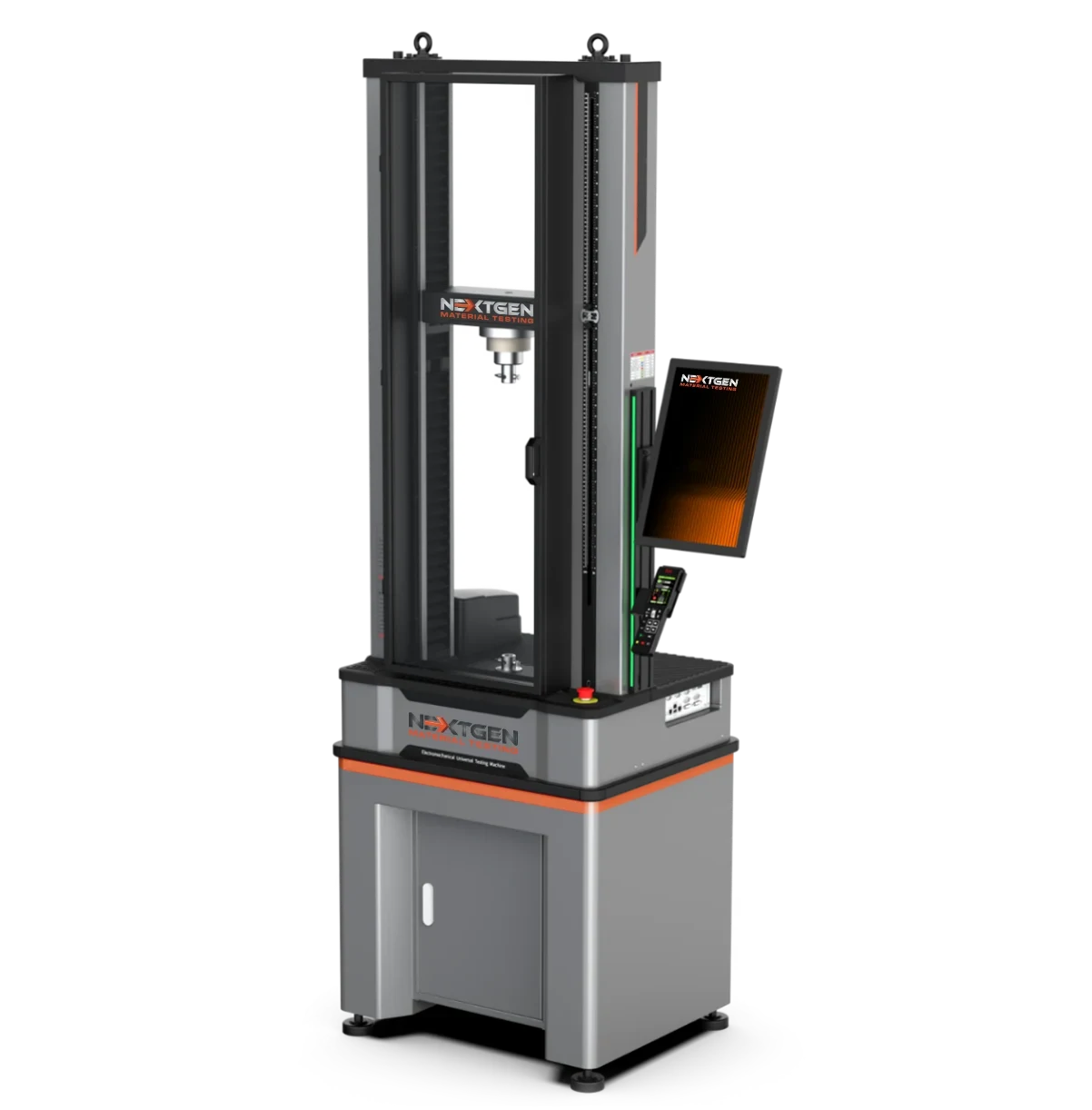
NG-EML Series B – Dual Column Bench Top Universal Testing Machine (100 N – 10 kN)
The NG-EML Series B is a high-precision dual-column benchtop universal testing machine engineered for tensile, compression, and flexural testing in the 0.1 kN to 10 kN range. It features Class 0.5 accuracy, a rigid FEM-optimized frame, and a direct-drive servo system with advanced closed-loop control, making it ideal for testing rubber, plastics, metals, composites, and high-performance polymers in both R&D and quality assurance settings.
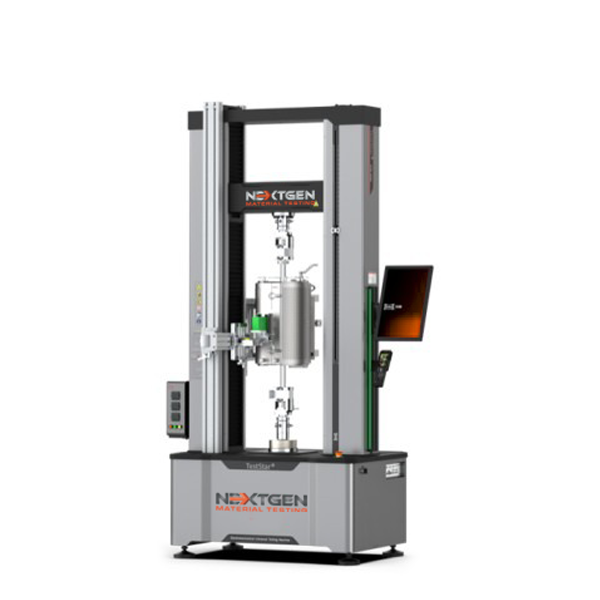
NG-EML Series C – Dual Column Bench Top and Floor Standing Universal Testing Machine (5 kN – 50 kN)
The NG-EML Series C is a precision-engineered dual-column universal testing machine for tension, compression, and flexural testing of metals, composites, rubbers, and polymers. Available in both bench-top and floor-standing formats, with force capacities from 5 kN to 50 kN and Class 0.5 accuracy.
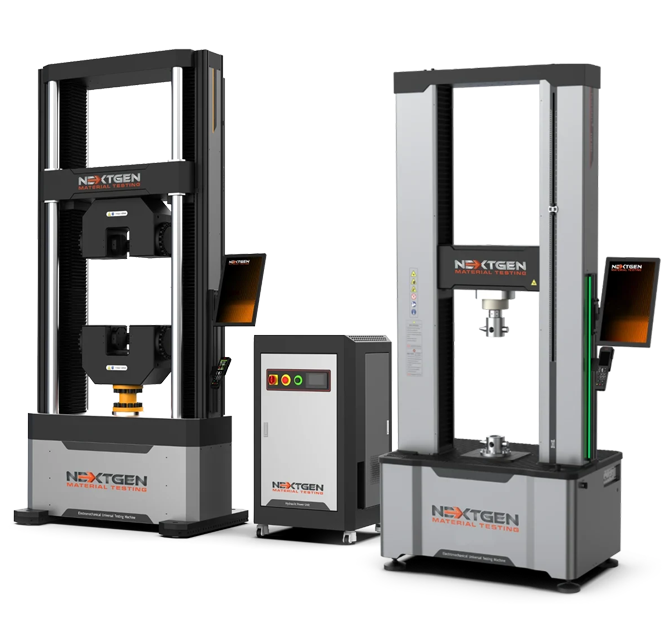
NG-EML Series D – Floor Standing Universal Testing Machine (50 kN – 1000 kN)
The NG-EML Series D – Floor Standing Universal Testing Machine (50 kN–1000 kN) is a dual-column system for tensile, compression, flexural, shear, and cyclic testing of high-strength metals, composites, polymers, and advanced materials. Available in single-space and dual-space configurations, it meets ASTM E8, ISO 6892-1, ISO 527, and GB/T 228 standards. With closed-loop control, 1200 Hz sampling, ultra-low speeds (0.00005 mm/min), and waveform generation, it is ideal for aerospace, automotive, construction, and research labs.
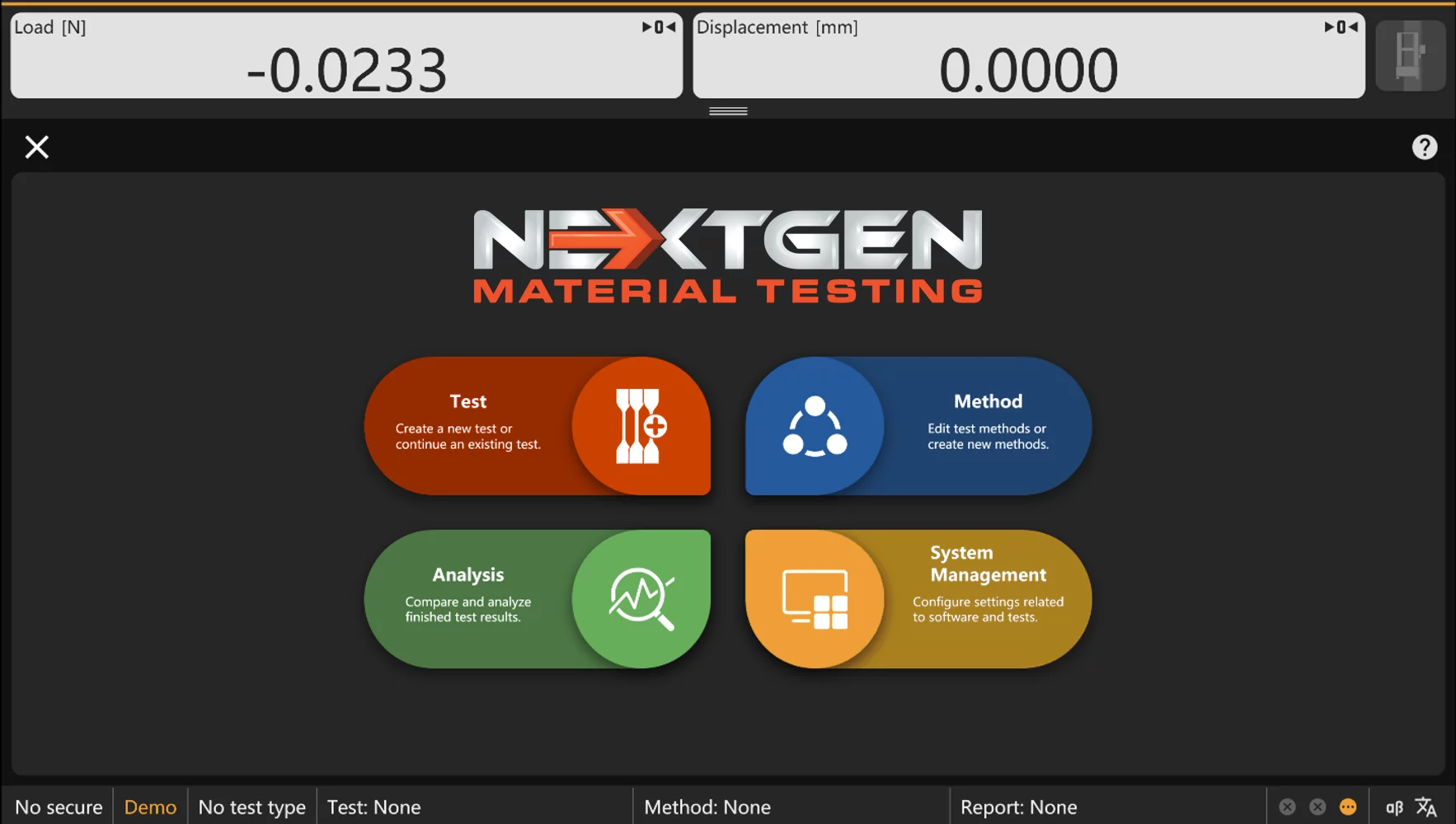
GenTest Data Acquisition Software - Advanced Universal Testing Machine Software
Upgrade to GenTest, the latest data acquisition software for universal testing machines. Ensure precise, repeatable material testing with an intuitive interface, powerful analysis tools, and full compliance with ASTM, ISO, DIN, and more.
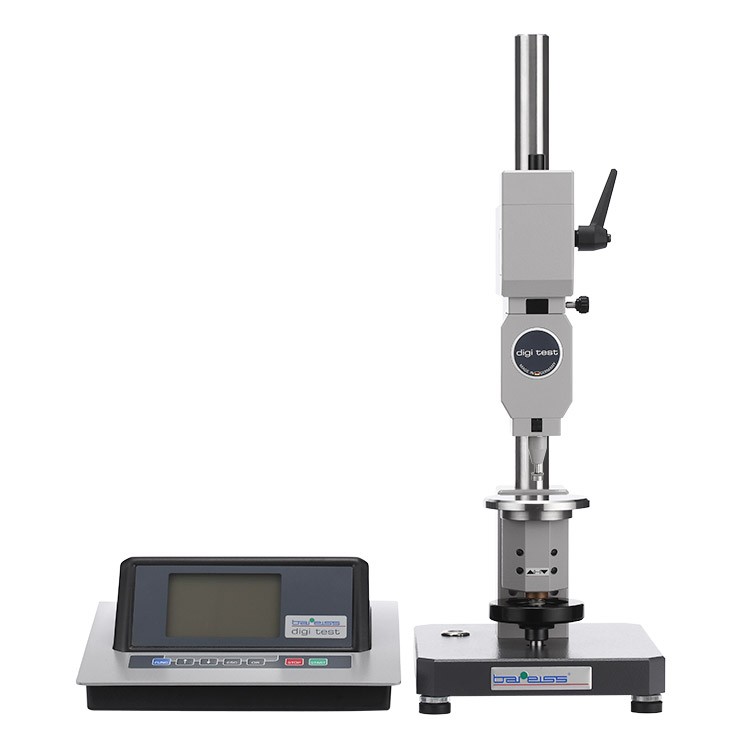
Automatic Shore, IRHD and VLRH Hardness Testing System
NextGen is proud to present our German line of fully-automatic Shore, IRHD and VLRH hardness testing system for plastic materials, plastic and foam compounds for the ultimate precision, accuracy and repeatability, exceptional ease-of-use and maintenance. Experience the industry leader for specimen testing including rubbers, plastics, foams, composites, o-rings, and more.
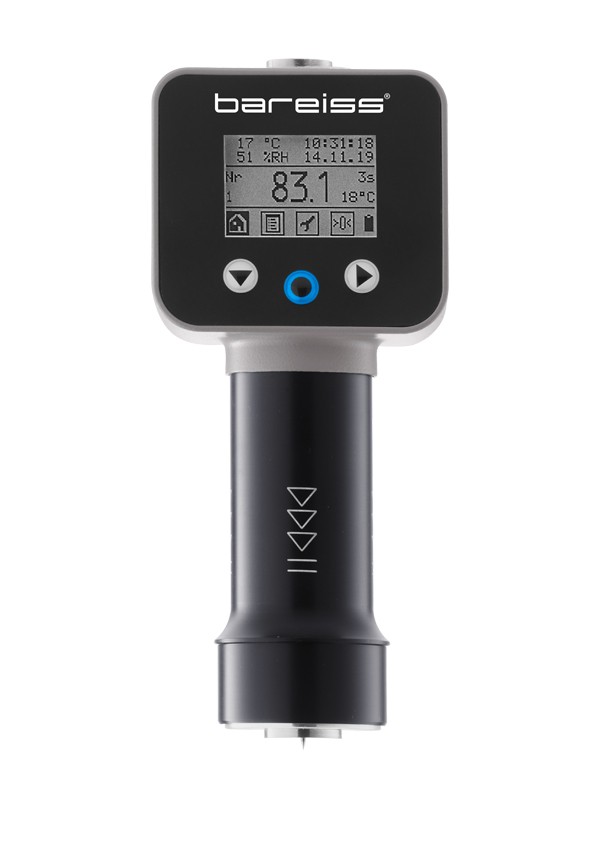
Advanced Portable Shore Durometer System with Test Stand Options
HPEIII is NextGen's advanced German line of equipment that is the new generation of HPE systems ideal for various plastic and plastic compound testing. The new system enhancements offer advantages including temperature sensor, reading values of ambient temperature and humidity, historical hardness value display, larger LCD display, standard USB connection and much more. These advanced portable systems can be paired up with either manual or automatic motorized test stands to help eliminate the human error factor and maximize accuracy and repeatability between test when switching from one operator to the next.
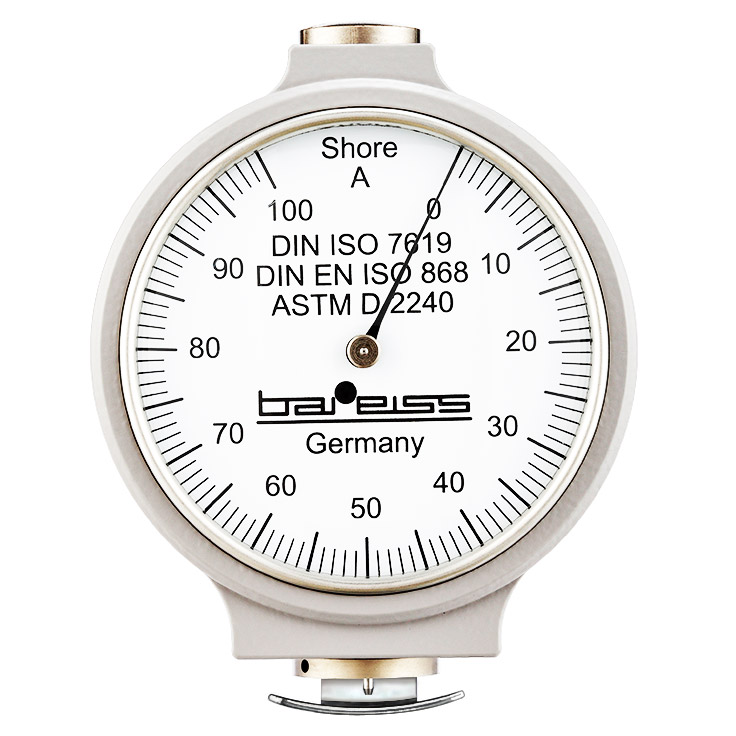
Classic Analogue Shore Durometer with Test Stand Options
This German-manufactured system has been the global benchmark of Shore hardness testing systems since 1954. With ever enhanced ergonomic design, the HP Shore Hardness Tester is both visually appealing and precise rubber and plastic testing system as it has been for nearly 50 years.
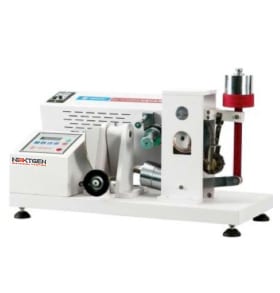
Akron Abrasion Tester
GenKron is used together with a special balance for testing the abrasive consumption of materials. The measurements are done through volumetric loss of a rotating specimen exposed to the action of a standard grinding wheel. It is especially suited for testing harder materials such as shoe soles, tires and other rubber materials.
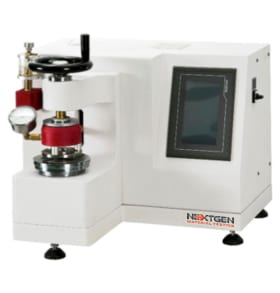
Burst Strength Tester for Fabric
GenBurst is the Burst Strength Tester designed to test anti-rupture strength of variety of materials such as leather, paper and fabric.
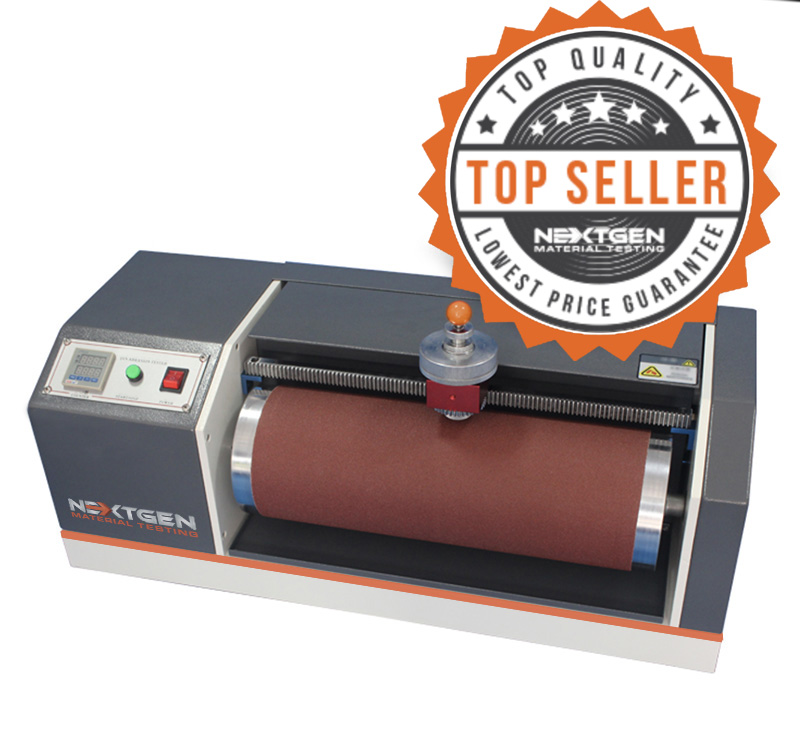
DIN Abrasion Tester
GenDin, is designed to conform to the ASTM D5963 and IS0 4649 standards. This top quality and highly popular abrasion tester will allow you to measure the abrasion resistance of rubbers (vulcanized thermo set rubbers and thermoplastic elastomers) that are subject to abrasive/frictional wear on their actual service. Since wear is always a result of abrasion, different test methods have been developed for the simulation of long term wear.
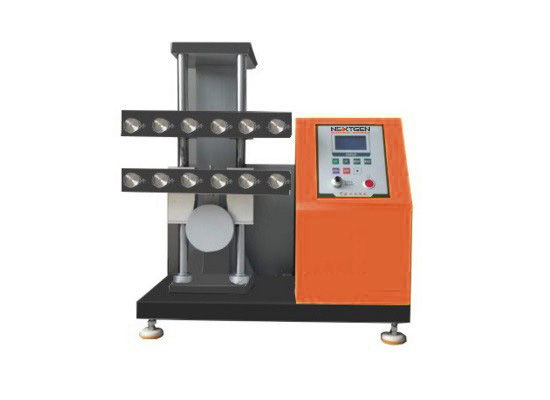
Demattia Flex Cracking Tester
GenFlex tests the ability of rubber products to withstand repeated flexing without developing cracks is of prime importance where such products are used in conditions undergoing repeated flexing. Flexing endurance of rubber products is determined by simulating in laboratory the action of flexing repeatedly under standard conditions of speed, mode, and degree of flexing.
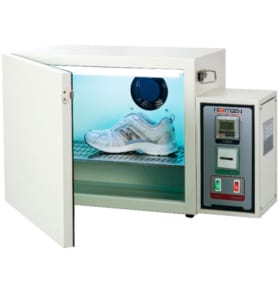
Discoloration Meter
The machine is used to simulate an environment of sunlight radiation on a specimen to identify the resistance of fabric to discoloration.
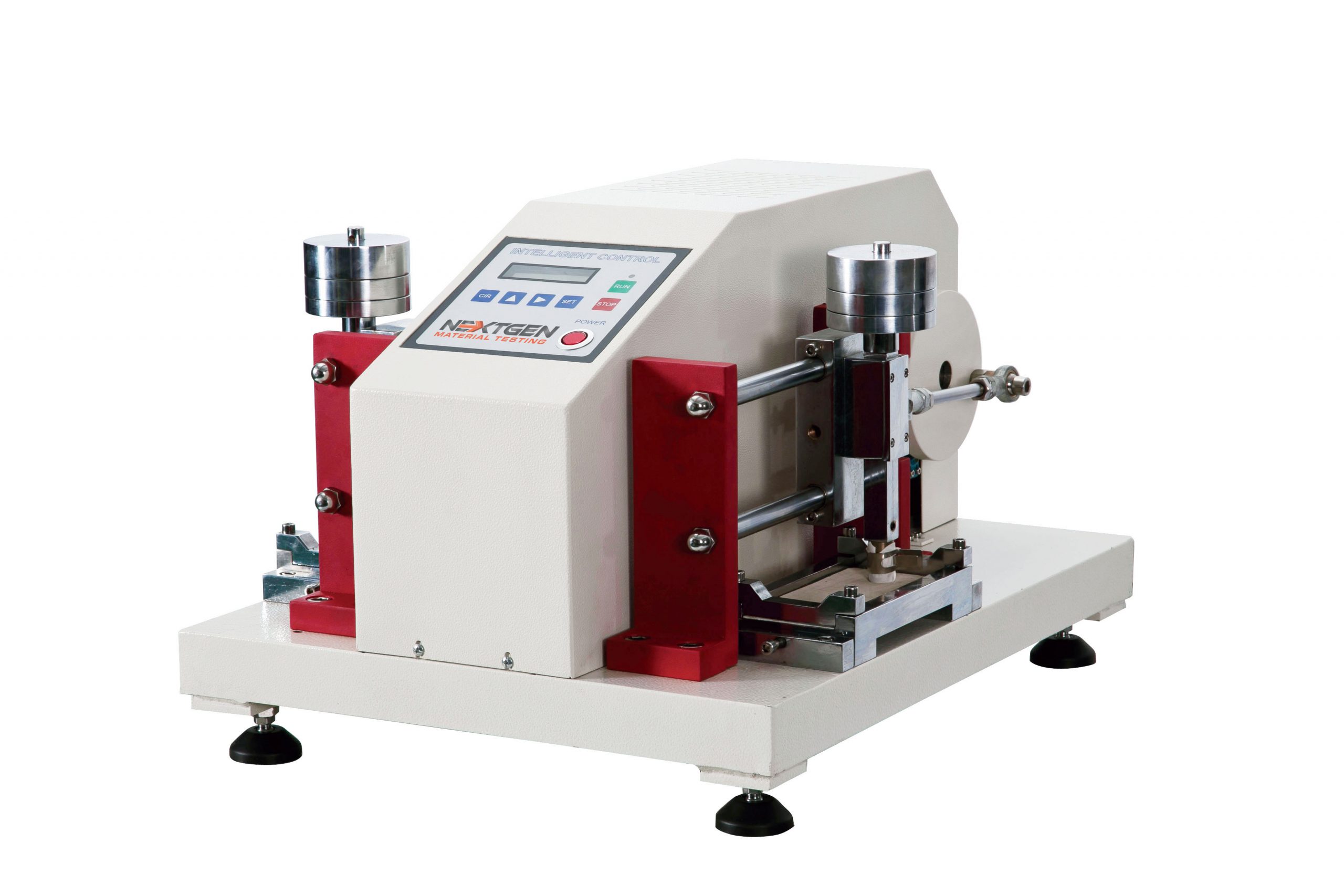
Electric Crocking Tester - GenCrock
The machine is used to test the dyeing of the fabric, and the fade degree of the leather after dry or wet rubbing. The test method involves the specimen to be fastened to the base of the crocking meter and rubbed with an abrasive hammer attached to a wet or a dry cloth under controlled conditions. The transfer of colour is then measured using a scale to evaluate the rating of the specimen's dyeing grade.
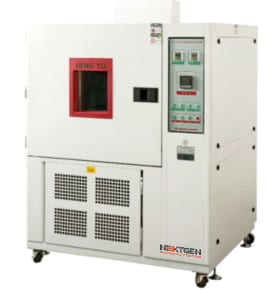
Freezing Tester - GenFreeze
GenFreeze is specially designed to test the characteristics of various materials in a cold environment to ensure suitability for use in a cold climate. Based on the testing demand, adjust the beater and flexing grip, then load to the desired position. It can be used to test rubbers, leather, and plastics, PU leather etc. The unit can be adjusted to meet different requirements.
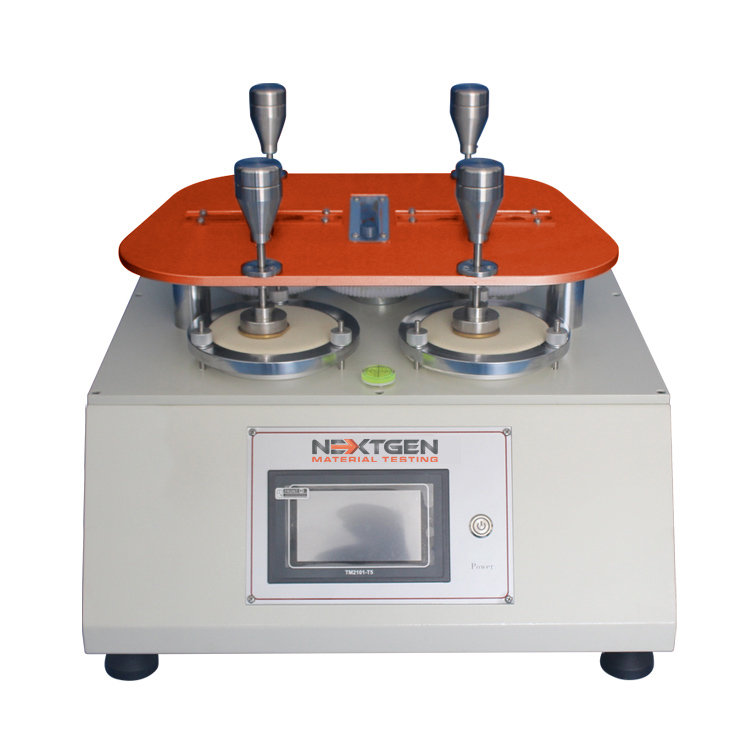
Martindale Abrasion Tester - GenDale
GenDale is mainly used to test shoe fabric, shoe lining, and many other types of shoe related materials. The unit can test up to four specimens at the same time for abrasion. The fabric specimen is measured by having rubbing applied on it via a complex direction of back and forth motion. The accuracy of abrasion strength is determined by the specific number of cycles conducted until a hole appears in the test area of the fabric specimen.
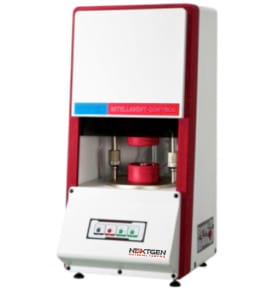
Mooney Viscosity Testing Machine - GenMooney
GenMooney is a viscosity testing machine is applied to measure the viscosity of the unmixed or mixed unvulcanized natural rubber, synthetic rubber and regenerated rubber .This tester has many functions such as fast warming, maintaining temperature, data stability, etc. It is equipped with an automated calibration feature for a simple data calibration of each experiment.
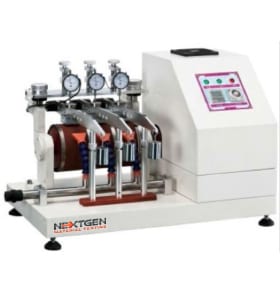
NBS Rubber Abrasion Tester - GenNBS
GenNBS is used to test the abrasion resistance of vulcanized rubber or other rubber compounds. It is commonly used for the soles and heels of footwear. It has an intelligent power failure recovery system. The unit conducts measurements through volumetric loss of specimens exposed to the action of a normalized abrasive medium secured to a rotations cylinder.
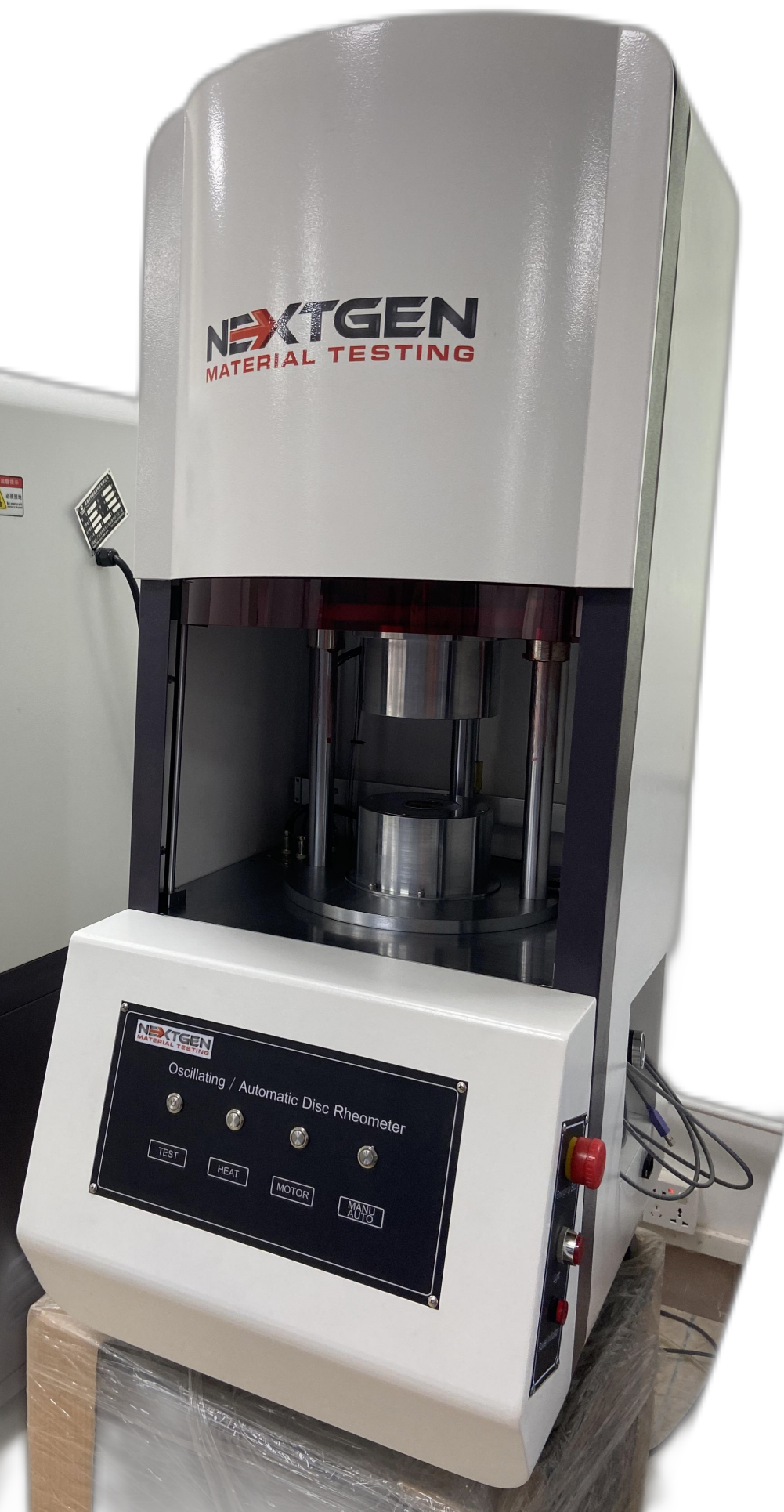
Oscillating / Automatic Disc Rheometer (ODR)
This machine is designed to get the characteristic curve and characteristic parameters of rubber vulcanization by measuring the applied moment of rubber to the oscillating dye body. NG-ODR rotor-free vulcameter has an excellent stability of results. The data and diagrams can be used as a reference for development, research and production quality.
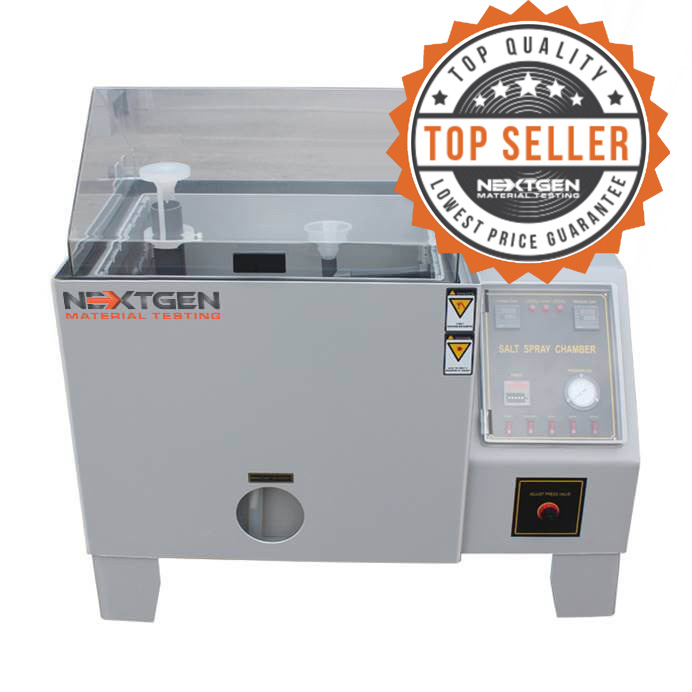
Salt Spray Tester - GenSalt
GenSalt is designed to test the surface of different materials for resistance to corrosion. The unit is commonly used to test coated materials of a metallic nature in a controlled corrosive environment. The test can be used on rust-proof painting, anodizing, electroplating and rust-proof of grease. The machine imitates expedited corrosion process via salt spraying on a given test sample to identify the corrosion (oxides) resistance. Test results are based on the longevity of time a material can resist visible corrosion on the test sample.
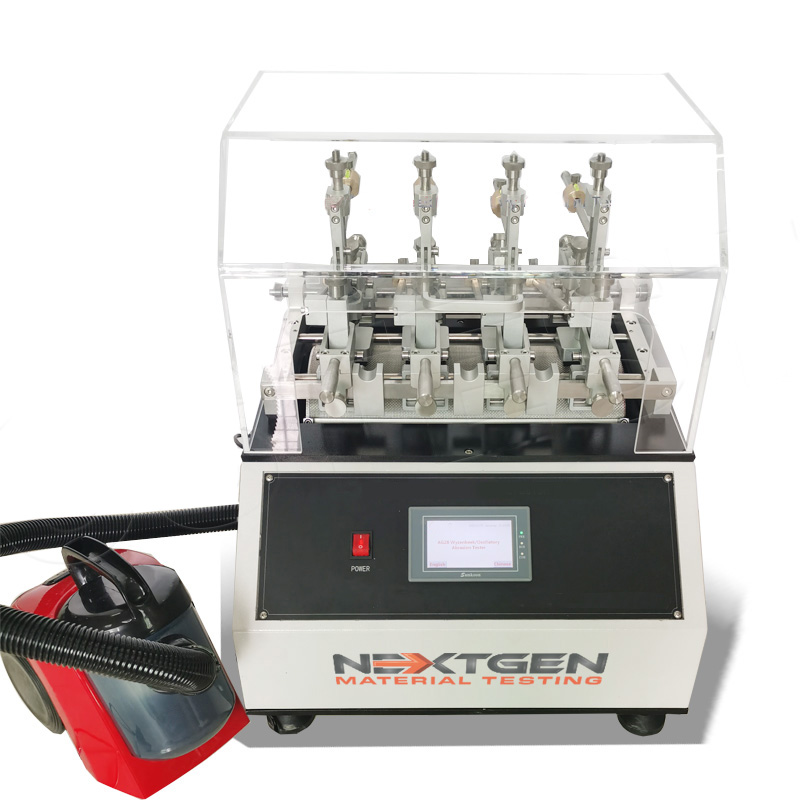
Wyzenbeek Abrasion Tester - GenWyze
The machine is designed to test the abrasion resistance of fabrics and metals. The abrasion of fabrics is tested when the specimen is pulled over the frame and rubbed against an abradant over a curved surface. The number of cycles, also known as double rubs, conducted on the specimen before the fabric shows visible wear is used to determine the rating of abrasion.

Vertical Rebound Resilience Tester - GenRebound
GenRebound tests the resilience of rubber compounds. The machine must be adjusted in a horizontal position and the plunger raised at a specific height. The plunger is then released onto the specimen for a given number of impacts. The measurements are based on the 4th, 5th, and 6th impacts. The average of the three (3) measurements is then calculated for the test result. The machine is highly useful in production of compounds designed to absorb vibration or shock according to the ASTM standards.
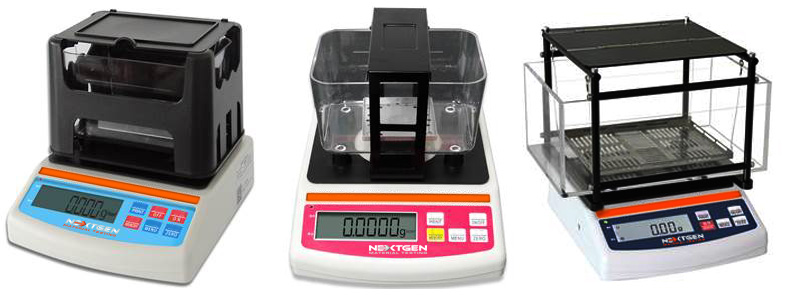
Digital Densimeter Systems
Description The NG-DM-A Series offers high-accuracy digital Densimeters designed for a wide variety of material testing needs. These elegant and compact densimeter systems offer capacity ranges from 150g to 3000g with accuracy of 0.001g/cm3 down to 0.0002g/cm3. Advanced Densimeter System […]
